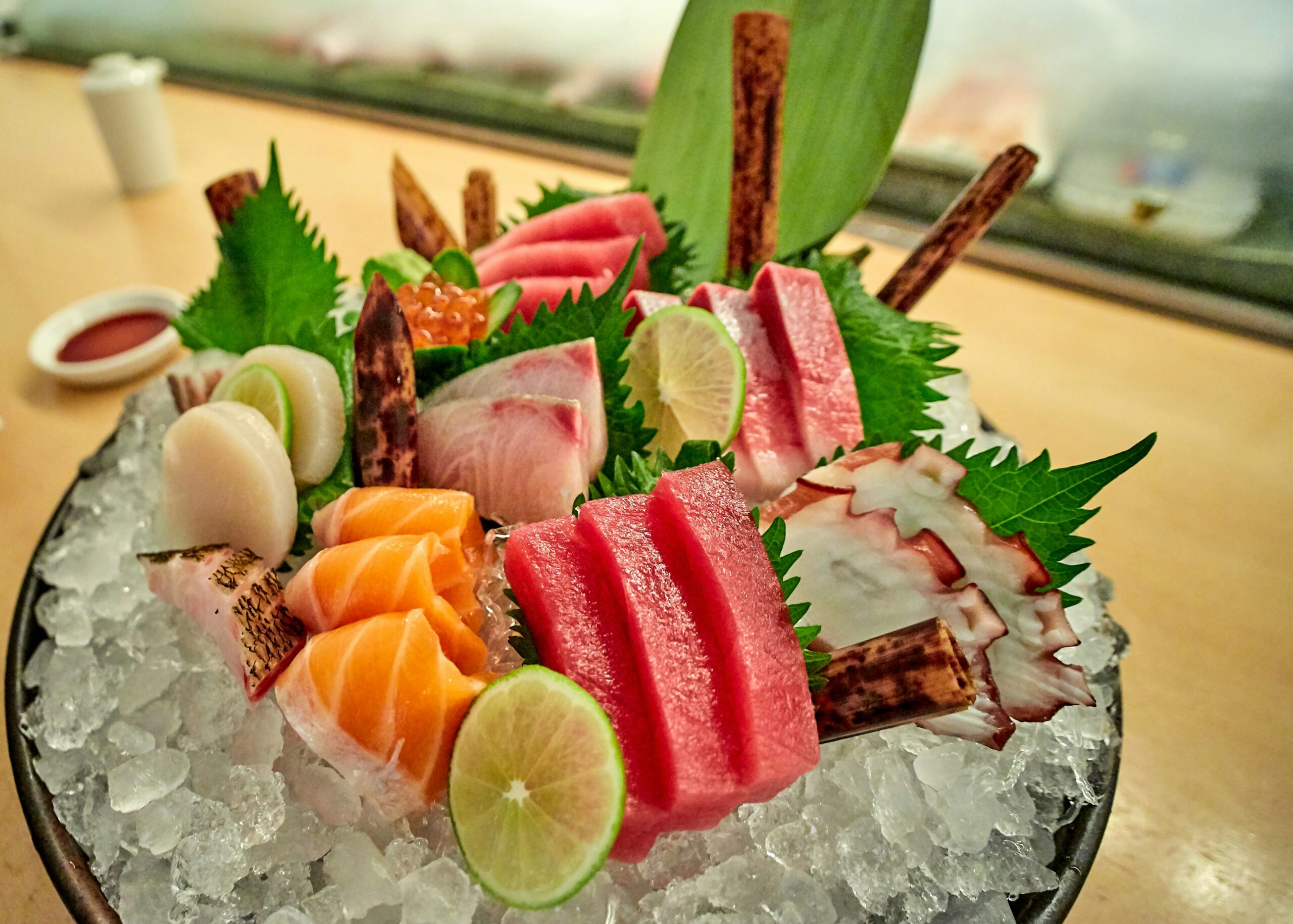 さしみ さしみは日本の美味であり、生魚か生肉を小さく切り醤油につけて食べられます。 | Sashimi is a Japanese delicacy consisting of fresh raw fish or meat sliced into thin pieces and often eaten with soy sauce. 「delicacy: 美味」 |
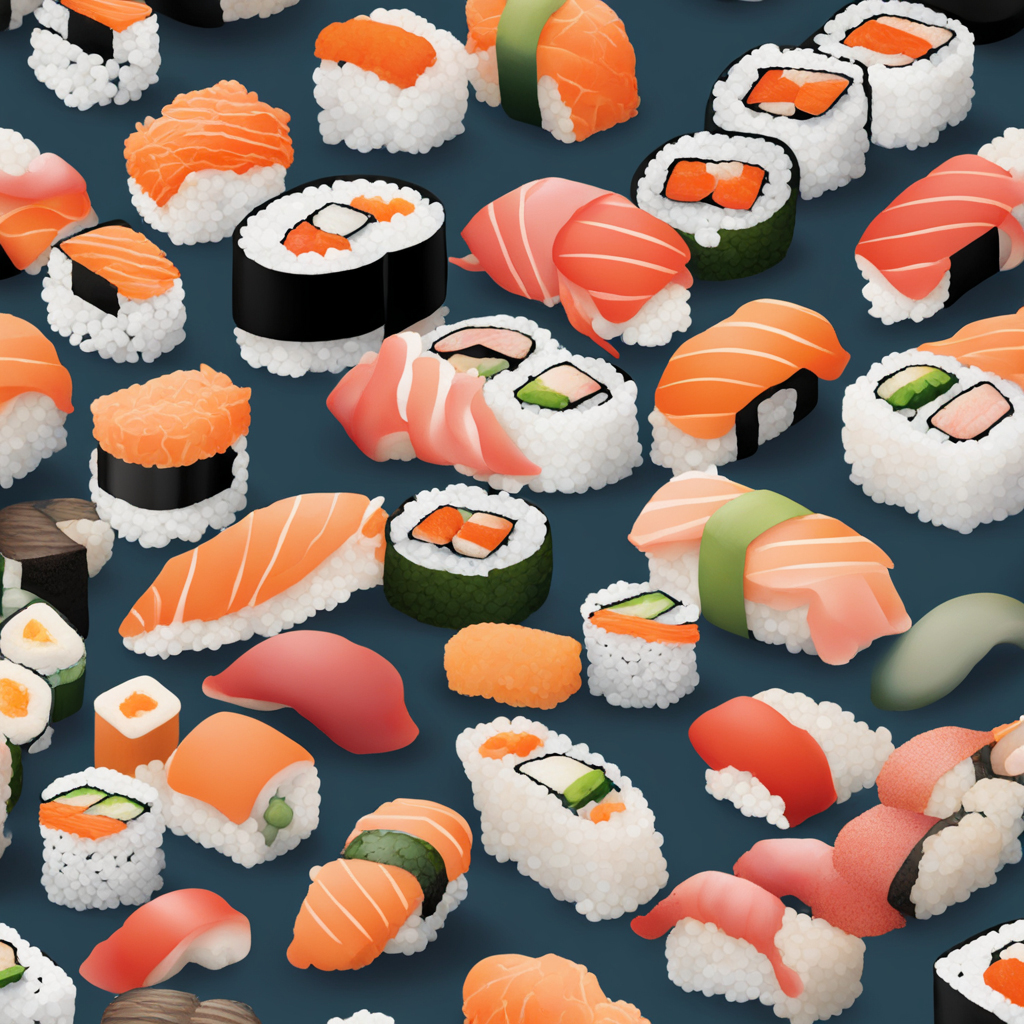 すし すしとは酢飯とそのほかの材料、一般的に生魚と野菜を組み合わせた和食です。寿司のスタイルはいろいろですが、主材料となるのは酢飯です。 | Sushi is a Japanese dish of prepared vinegared rice, accompanied by a variety of ingredients, such as seafood, often raw, and vegetables. Styles of sushi vary widely, but the one key ingredient is vinegared rice. 「vary: 変わる」「ingredient: 材料」 |
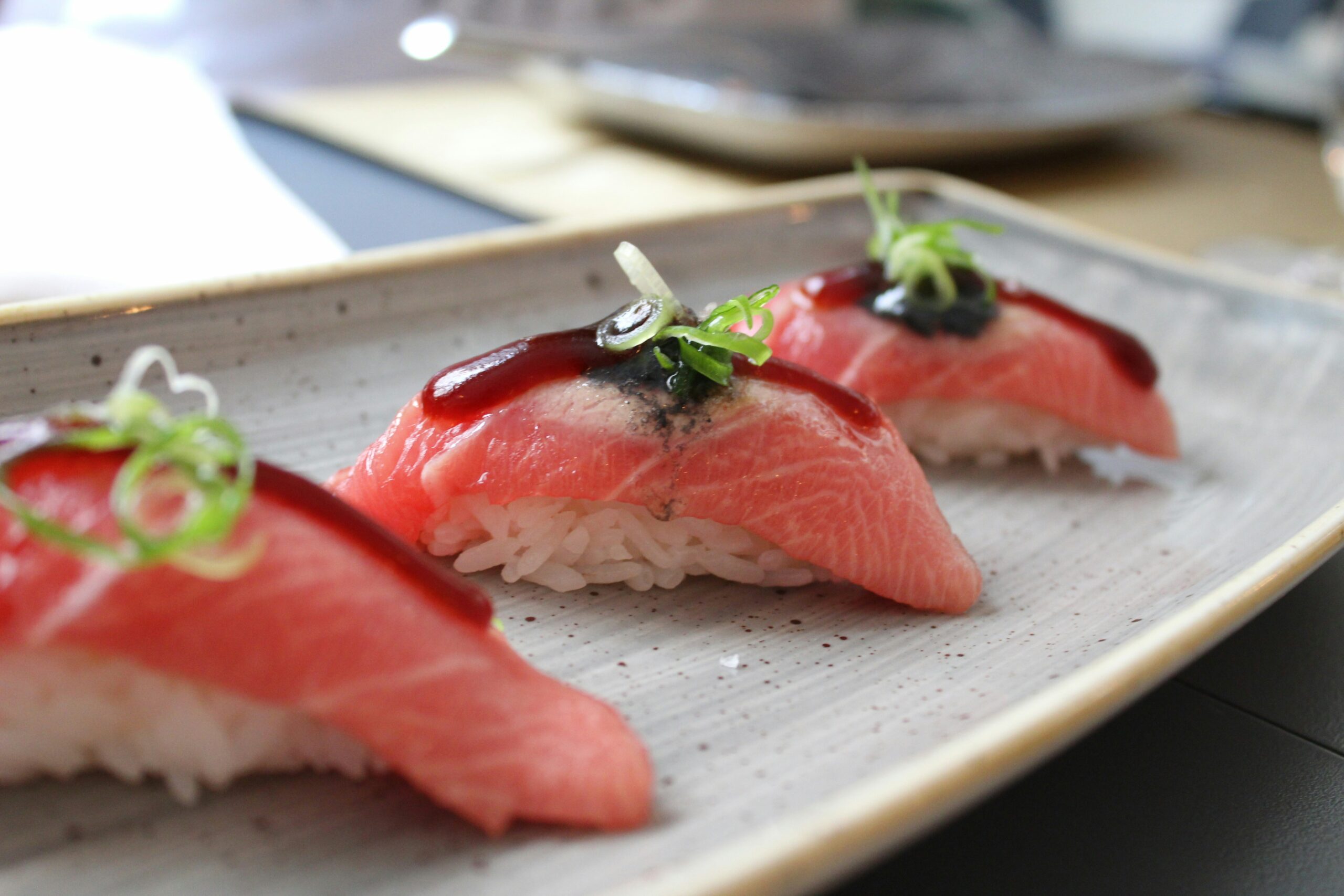 握りずし 握りずしは寿司職人が両手の平で押して作った長方形の米の土台とその上に覆いかぶさるトッピング(ネタ)からなります。通常ワサビとともに出されます。 | Nigirizushi consists of an oblong mound of sushi rice that a chef typically presses between the palms of the hands and a topping (the neta) draped over the ball. It is usually served with a bit of wasabi. 「oblong: 長方形の」「mound: 盛り上がったもの」「oval-shaped: 卵型の」「drape over: を覆う」 |
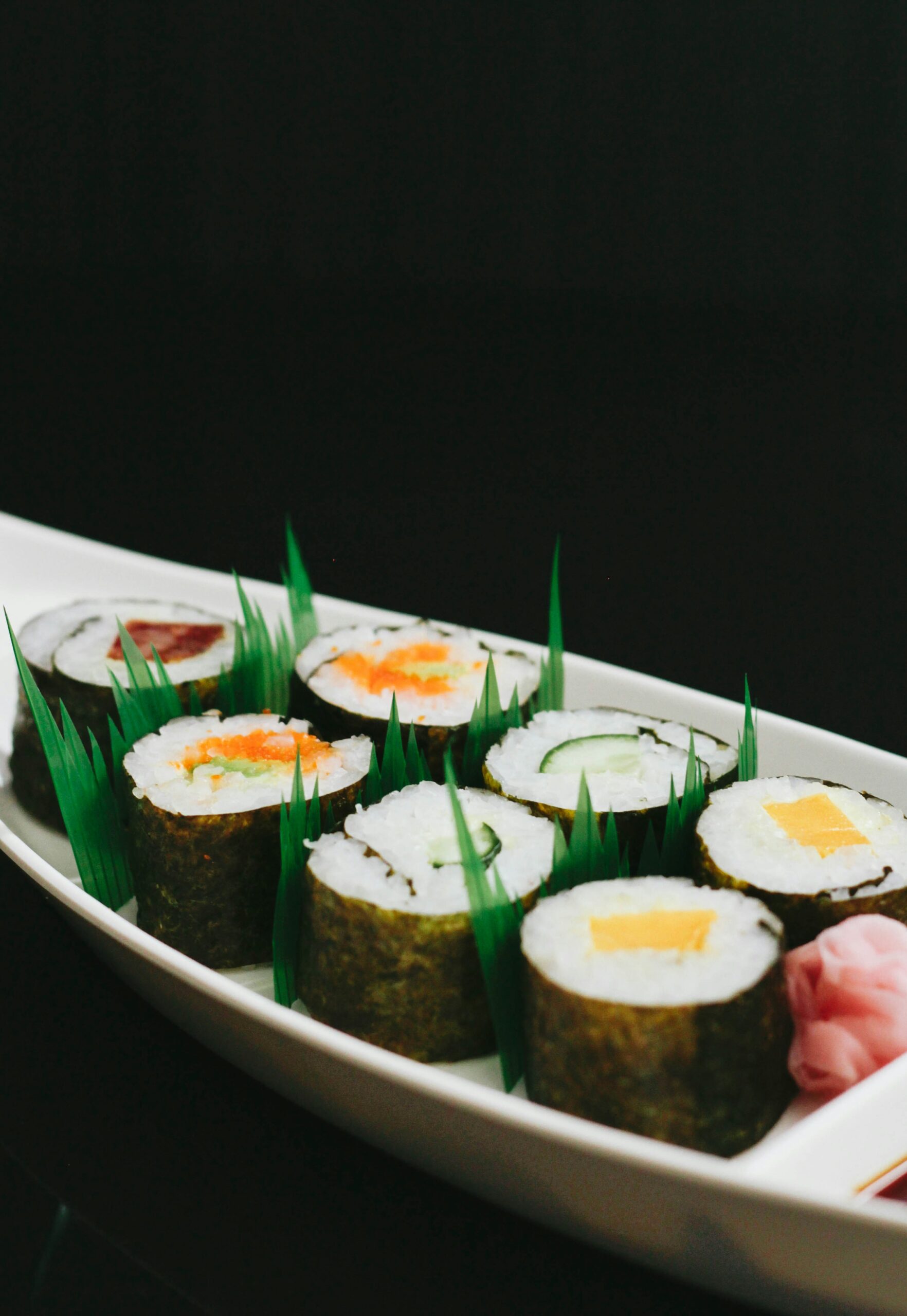 海苔巻き 「海苔巻き」(のりまき)は、日本料理における寿司の一形態で、寿司ロールまたは巻き寿司としても知られています。寿司飯、海鮮や野菜などの様々な具材、そして海苔(のり)のシートが一緒に巻かれます。巻き寿司は、食べやすい大きさに切り分けられます。テッカ巻き(マグロ巻き)、カリフォルニアロールなど、様々な種類の海苔巻きがあり、それぞれ独自の具材の組み合わせが特徴です。 | Norimaki, or sushi rolls, are a popular form of sushi in Japanese cuisine. They consist of vinegared rice, various ingredients such as seafood, vegetables, and sometimes tropical fruits, and a sheet of nori (seaweed) rolled together. The roll is then sliced into bite-sized pieces. There are various types of norimaki, including traditional rolls like Tekkamaki (tuna roll)and California Roll, each with its unique combination of ingredients. 「bite-sized: 一口サイズの」 |
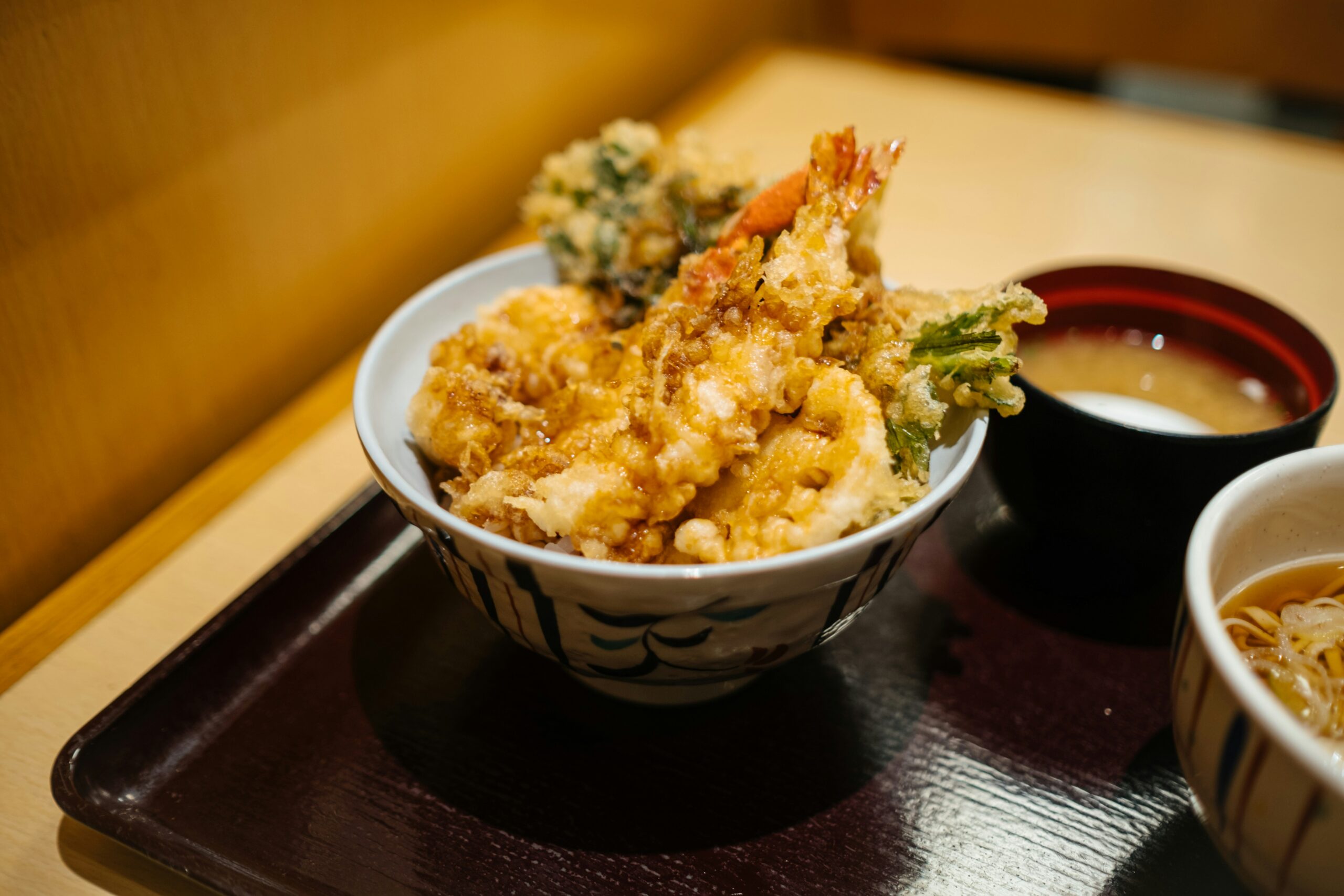 天ぷら 天ぷらとは典型的な和食で、衣をつけて油で揚げられた海鮮、肉、野菜からなります。 | Tempura is a typical Japanese dish usually consisting of seafood, meat and vegetables that have been battered and deep fried. 「batter: 衣をつける」 |
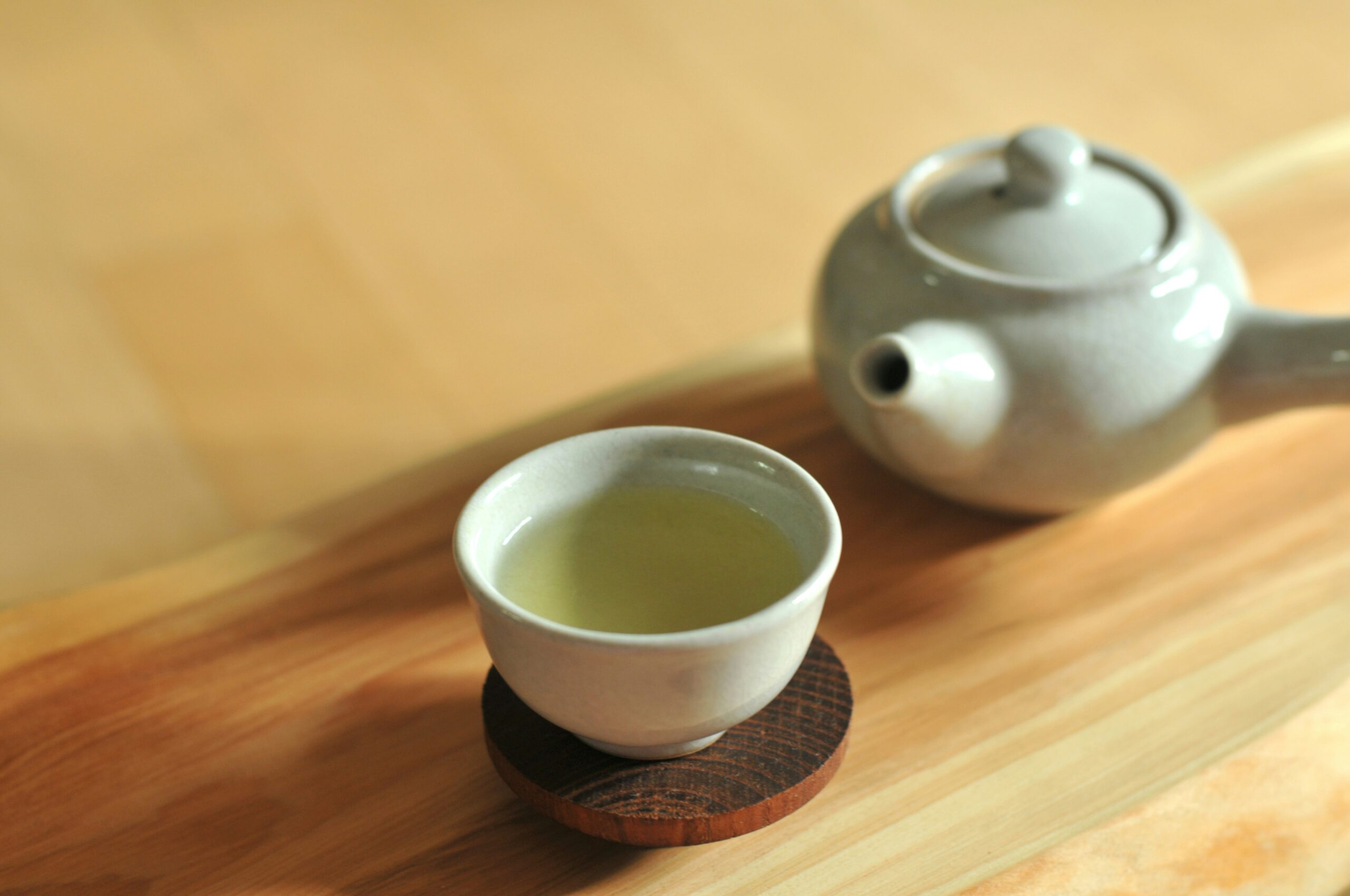 緑茶 緑茶は茶の木の葉っぱと芽から作られます。茶の種は9世紀に初めて最長と空海によって日本にもたらされました。 | Green tea is a type of tea that is made from Camellia sinensis leaves and buds. Tea seeds were first brought to Japan in the early 9th century by the Buddhist monks Saicho and Kūkai. 「Camellia sinensis: 茶の木(カメリアシネンシス)」 |
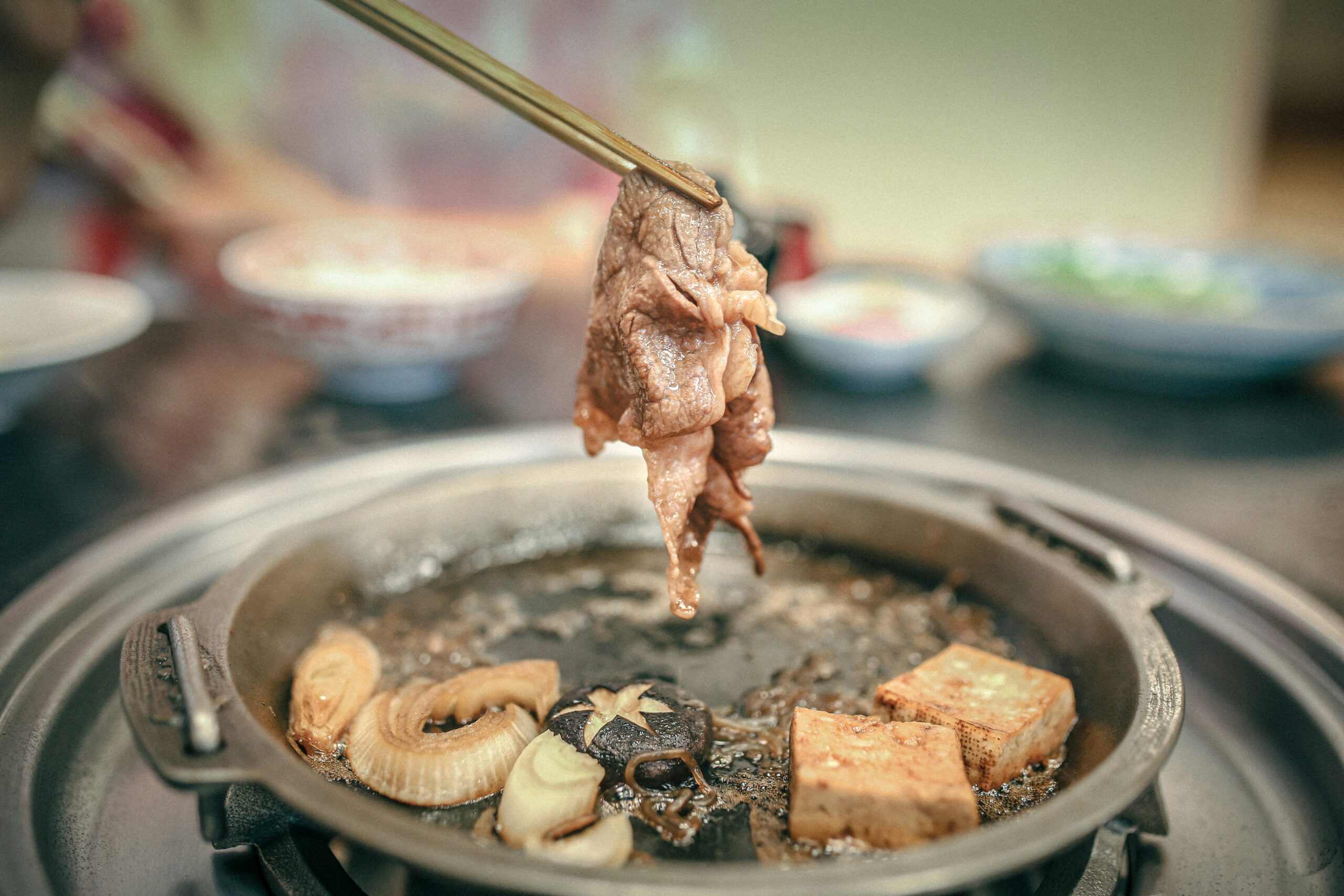 すき焼き すき焼きは、薄切りの牛肉が、醤油ベースの出汁で豆腐、きのこ、ねぎなどの様々な野菜と一緒にテーブルで調理される日本の鍋料理です。材料は浅い鍋で煮込まれ、食べる前に料理されたものを生卵の中にディップすることが一般的です。 | Sukiyaki is a Japanese dish where thinly-sliced beef is cooked in a soy source-based broth along with various vegetables such as tofu, mushrooms, and green onions. The ingredients are simmered in a shallow pot, and people often dip the cooked ingredients into a small bowl of raw, beaten eggs before eating. 「thinly-sliced: 薄切りの」「broth: 出汁」 |
 しゃぶしゃぶ しゃぶしゃぶは、薄切りの肉や野菜を煮立てた鍋で調理する、人気のある日本の鍋料理です。その名前「しゃぶしゃぶ」は、箸で具材を鍋の中でさっと動かすときに発生する音から派生した擬音語です。 | Shabu-shabu (しゃぶしゃぶ) is a popular Japanese hot pot dish that involves cooking thinly-sliced meat and vegetables in a pot of boiling broth. The name “shabu-shabu” is an onomatopoeic term derived from the sound that is made when you swish the ingredients in the hot broth using your chopsticks. 「onomatopoeic term: 擬音語」「swish: さっと動かす」 |
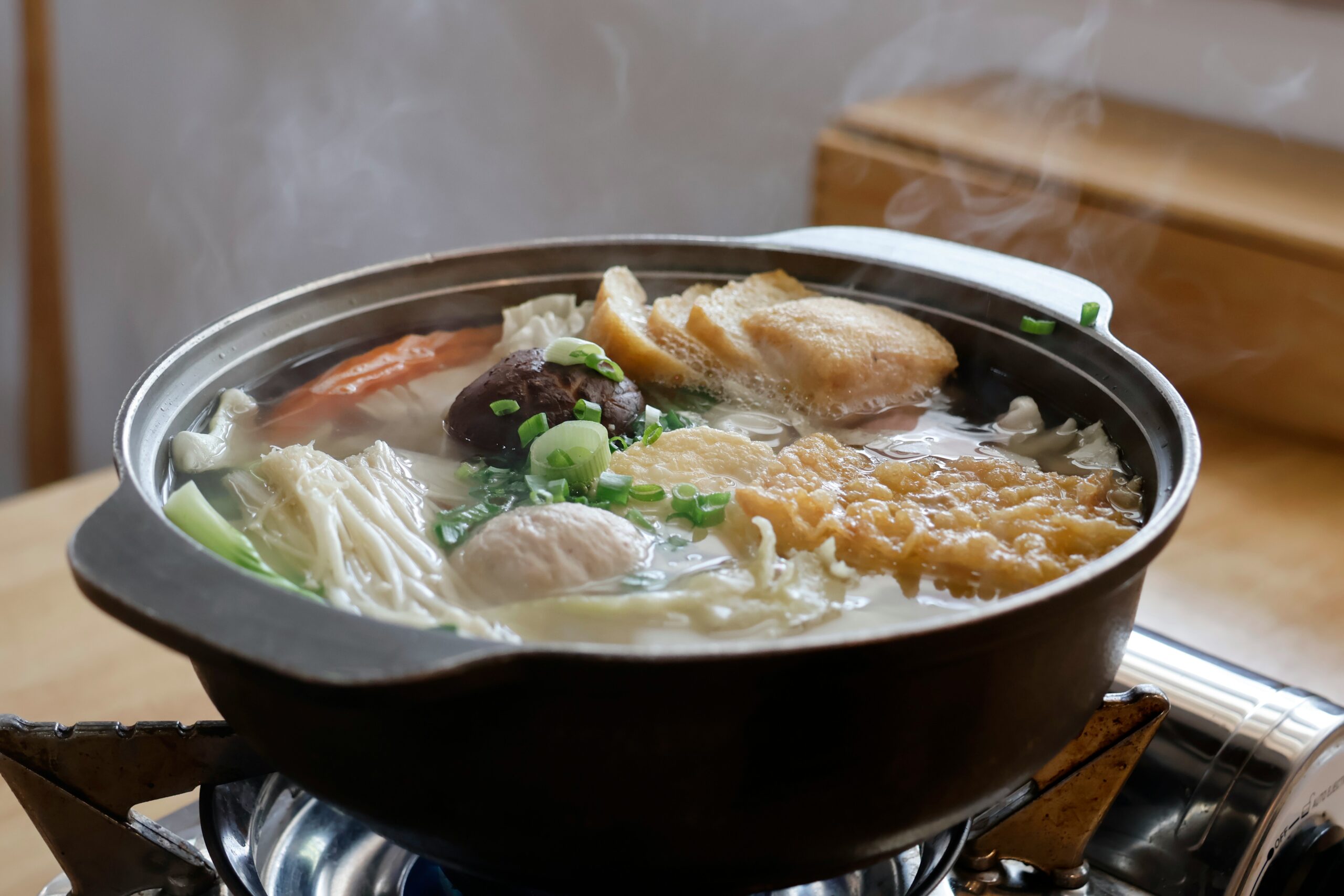 ちゃんこ鍋 ちゃんこ鍋(ちゃんこなべ)は、日本発祥の力士飯であり、主に相撲力士に関連しています。これは、薄切りの肉、魚介類、野菜、豆腐などさまざまな具材が組み合わさった、栄養たっぷりな鍋料理です。力士たちのトレーニングダイエットの一環としてよく食べられており、高いタンパク質を提供することで知られています。 | Chanko-nabe is a hearty and nutritious hot pot dish that originated in Japan and is closely associated with sumo wrestlers. It is a one-pot meal that typically contains a variety of ingredients such as meat, seafood, vegetables, and tofu. The dish is known for its high protein content and is designed to provide substantial energy to sumo wrestlers who consume it as a staple part of their training diet. |
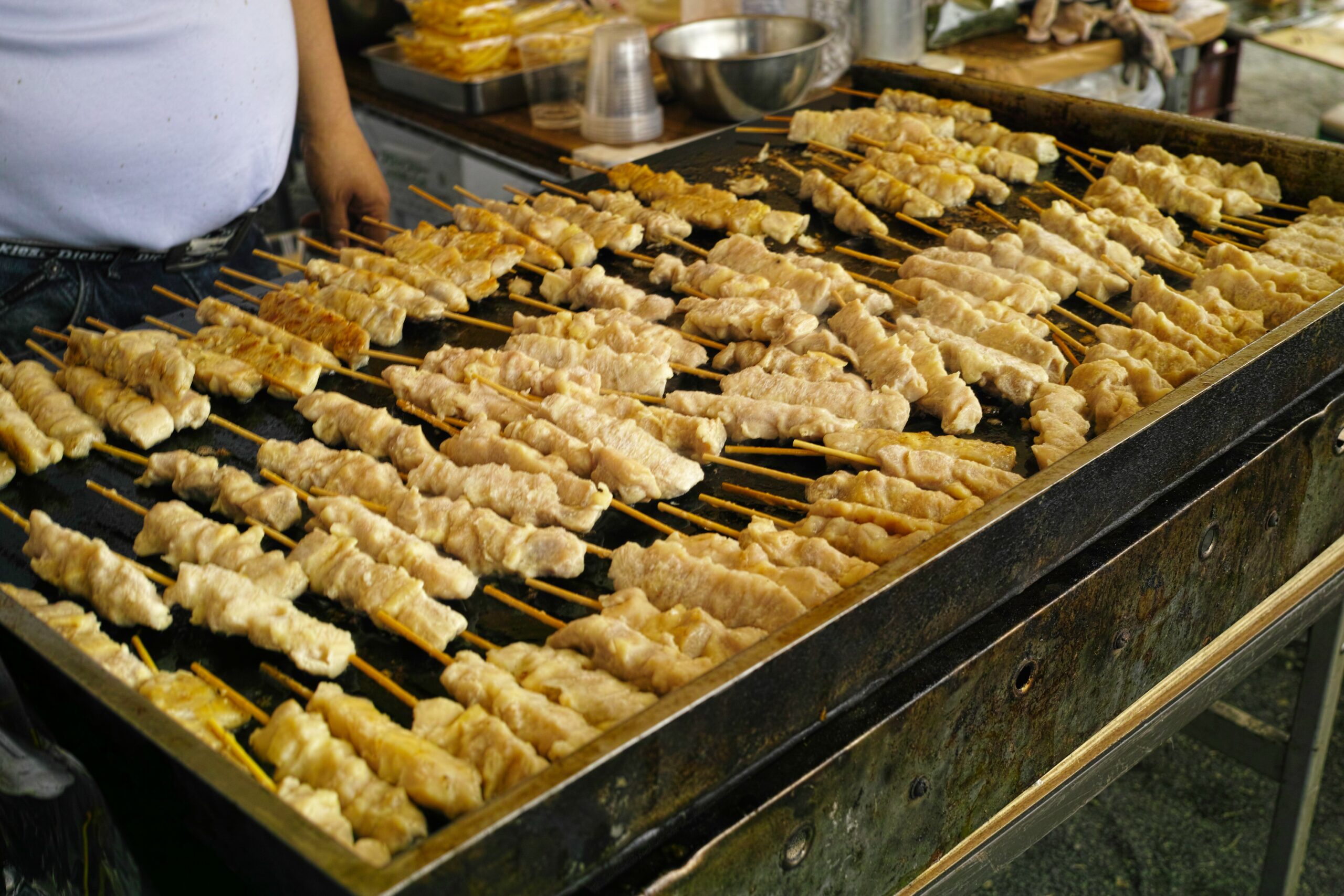 焼鳥 焼き鳥は、鶏肉を串に刺して焼いた日本料理の一つです。漢字で書くと「焼き鳥」で、「焼き」は焼く、そして「鳥」は鶏を意味します。通常、串に刺した鶏肉は味付けされ、焼かれ、日本料理で人気のある美味しい料理として楽しまれています。 | Yakitori is a Japanese dish of skewered and grilled chicken. In Japanese, it’s written as 焼き鳥, combining “yaki” (grilled) and “tori” (chicken). The chicken is typically seasoned and cooked on skewers, making it a popular and flavorful choice in Japanese cuisine. 「skewer: くし」 |
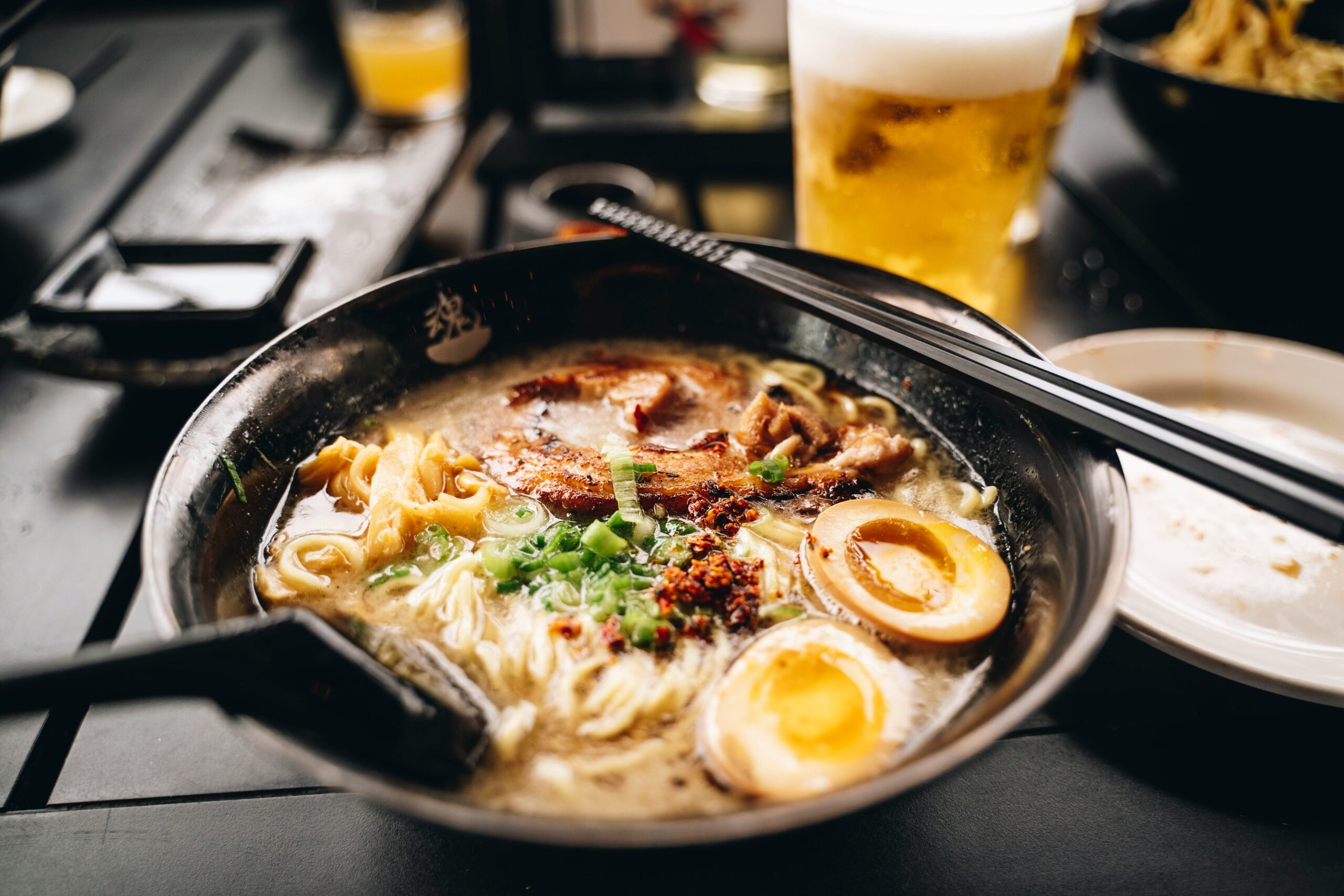 ラーメン ラーメンは中国発祥の人気のある麺料理で、主に中華麺とスープから成り立っています。具材としては、チャーシュー(豚肉の薄切り)、メンマ(発酵した竹の子)、ネギ、味付けた卵などが一般的に使われます。さらに、様々なスタイルや地域ごとに異なる種類があります。 | Ramen is a popular noodle dish that originated in China and typically consists of Chinese-style wheat noodles served in a meat- or fish-based broth. It is often flavored with soy sauce or miso, and toppings commonly include sliced pork (chashu), bamboo shoots (menma), green onions, and a seasoned boiled egg. Ramen comes in various styles and regional variations. |
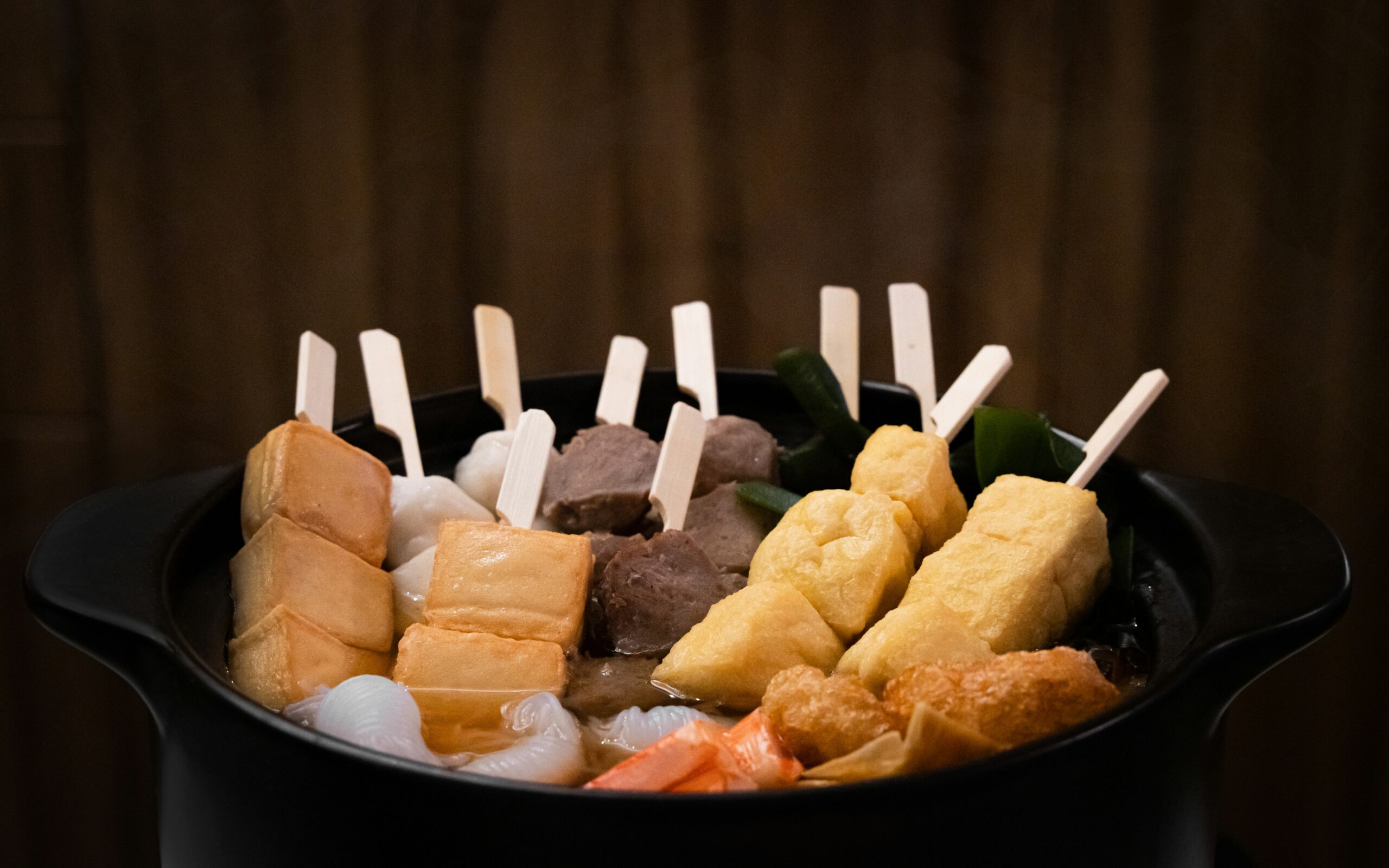 おでん おでんは、日本の伝統的な冬季料理で、様々な具材がだしで煮込まれた温かい料理です。主に大根、こんにゃく、卵、牛すじ、はんぺん、ちくわなどが使用され、これらの具材は特有のだしで煮込まれ、しっかりと味を染み込ませます。おでんは、日本の屋台や居酒屋で提供され、家庭でも手軽に楽しまれます。 | Oden is a traditional Japanese winter dish consisting of various ingredients simmered in a flavorful broth. Common ingredients include daikon radish, konnyaku (yam cake), eggs, beef tendons, hanpen (fish cake), and chikuwa (fish cake). These ingredients are simmered in a unique broth, allowing them to absorb the rich flavors. Oden is commonly served at street vendors, izakayas (Japanese pubs), and is also enjoyed at home as a comforting and warming dish during the winter season. 「simmer: にる」 |
 うどん うどんは、日本料理でよく使われる太い小麦粉の麺の一種です。通常は、透明なスープに入れて温かく供されるほか、つゆにつけて冷たく供されることもあります。うどんは噛み応えがあり、日本で人気のあるコンフォートフードです。 | Udon is a type of thick wheat flour noodle commonly used in Japanese cuisine. It is often served hot in a clear broth or with a dipping sauce, but can also be served cold with various toppings. Udon noodles have a chewy texture and are a popular comfort food in Japan. 「broth: だし汁」 |
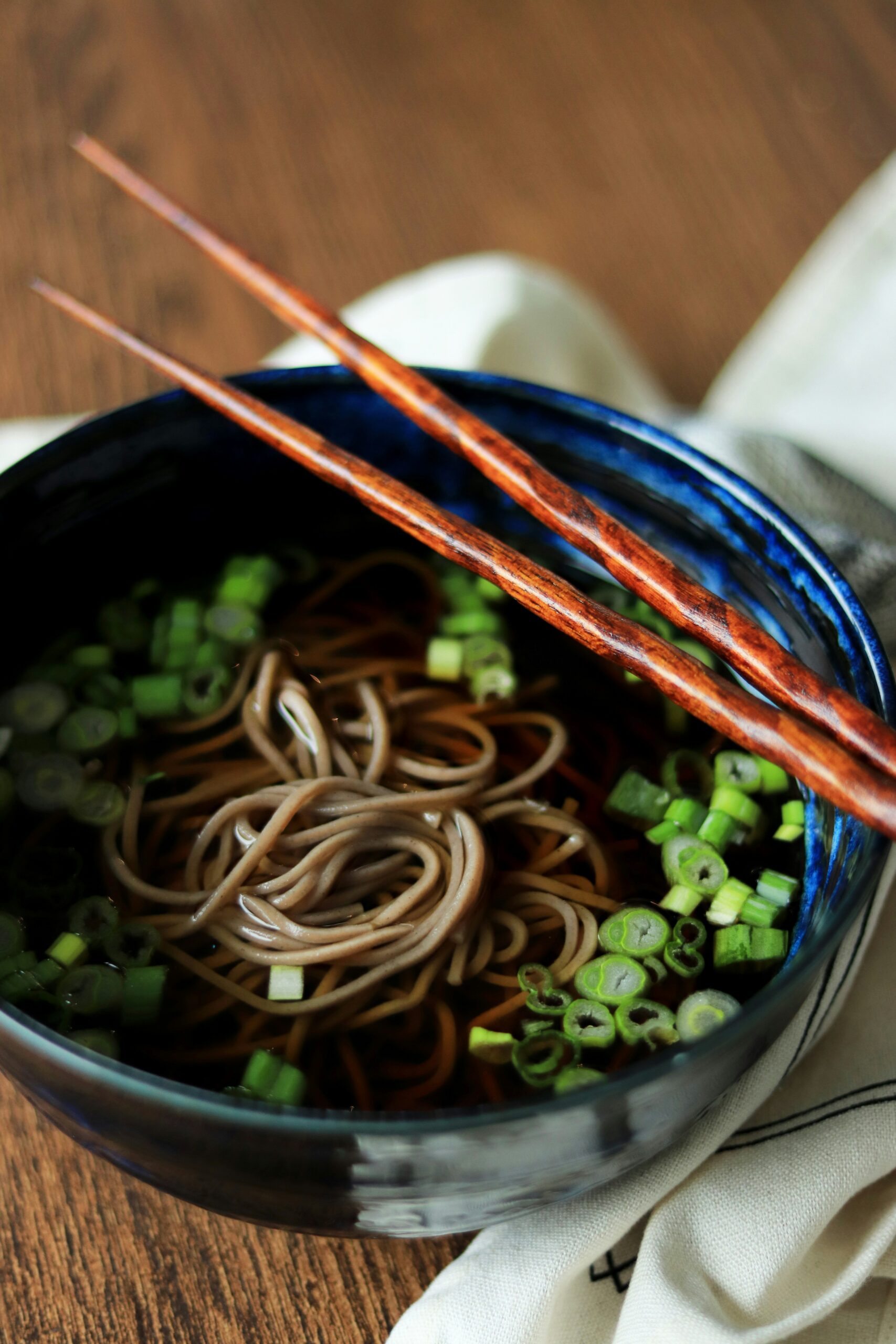 そば そばは、そば粉と水で作られる日本料理の定番です。温かいつけ汁やかけ汁と一緒に冷たくも温かくも楽しめ、ねぎや天ぷら、海藻などの具材が添えられることがあります。そばは風味豊かで食感が良く、グルテンフリーで栄養価も高い食材です。 | Soba noodles, made from buckwheat flour and water, are a staple of Japanese cuisine. They can be served hot or cold with a dipping sauce or in a broth, often garnished with green onions, tempura, or seaweed. Soba is prized for its nutty flavor and chewy texture, and it’s known for being gluten-free and nutritious. 「garnish: 飾り付ける」 |
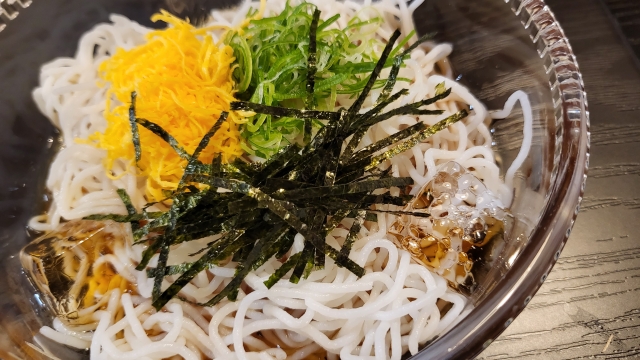 そうめん 素麺は、小麦粉で作られる細い日本の麺です。通常、冷やして提供され、暑い夏の季節に人気のある料理です。素麺は、食べる前に軽い醤油ベースのつけ汁や出汁につけて食べられることが一般的です。素麺は繊細な食感が特徴で、のりやねぎ、おろし生姜などのトッピングが添えられることがあります。 | Somen are thin Japanese noodles made from wheat flour. They’re typically served chilled and are a popular dish during hot summer months. Somen noodles are often dipped in a light soy-based sauce or broth before being eaten. They’re known for their delicate texture and are commonly garnished with toppings like shredded nori seaweed, sliced green onions, or grated ginger. 「shredded: きざまれた」「grated: おろし」 |
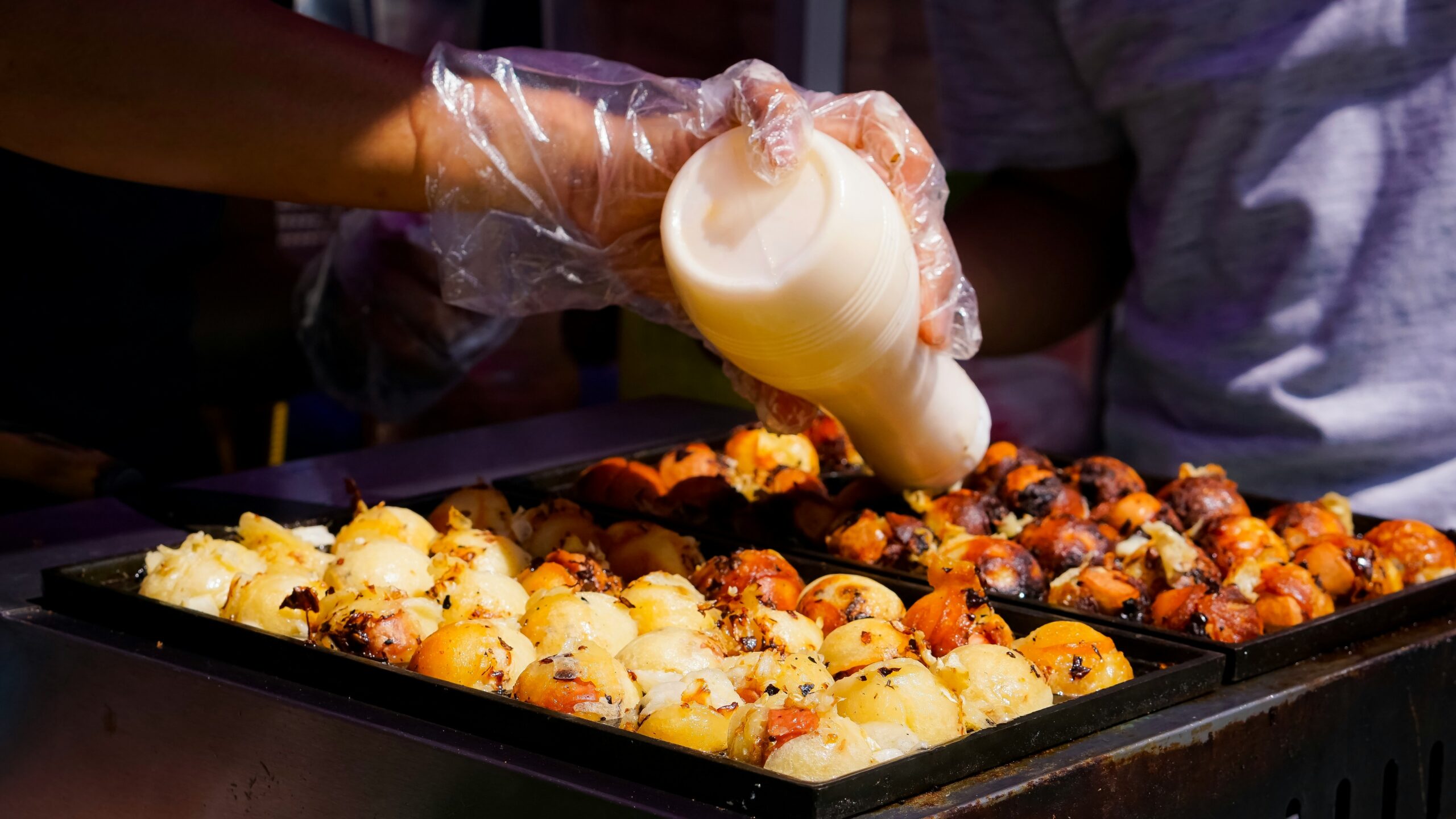 たこ焼き 「たこ焼き」は、タコの切り身や天ぷらのかす、漬け生姜、青ネギなどを入れた生地を特製の型に流し込み、丸い小さな球状に焼いた日本のスナックです。通常は熱々で、たこ焼きソース、マヨネーズ、鰹節、乾燥海苔などをトッピングして提供されます。 | “Takoyaki is a Japanese snack food made from a batter filled with octopus pieces, tempura scraps, pickled ginger, and green onion, cooked in a special molded pan to create small, round balls. It is typically served hot and topped with takoyaki sauce, mayonnaise, bonito flakes, and dried seaweed flakes.” 「batter: 生地」「bonito flakes: かつおぶし」 |
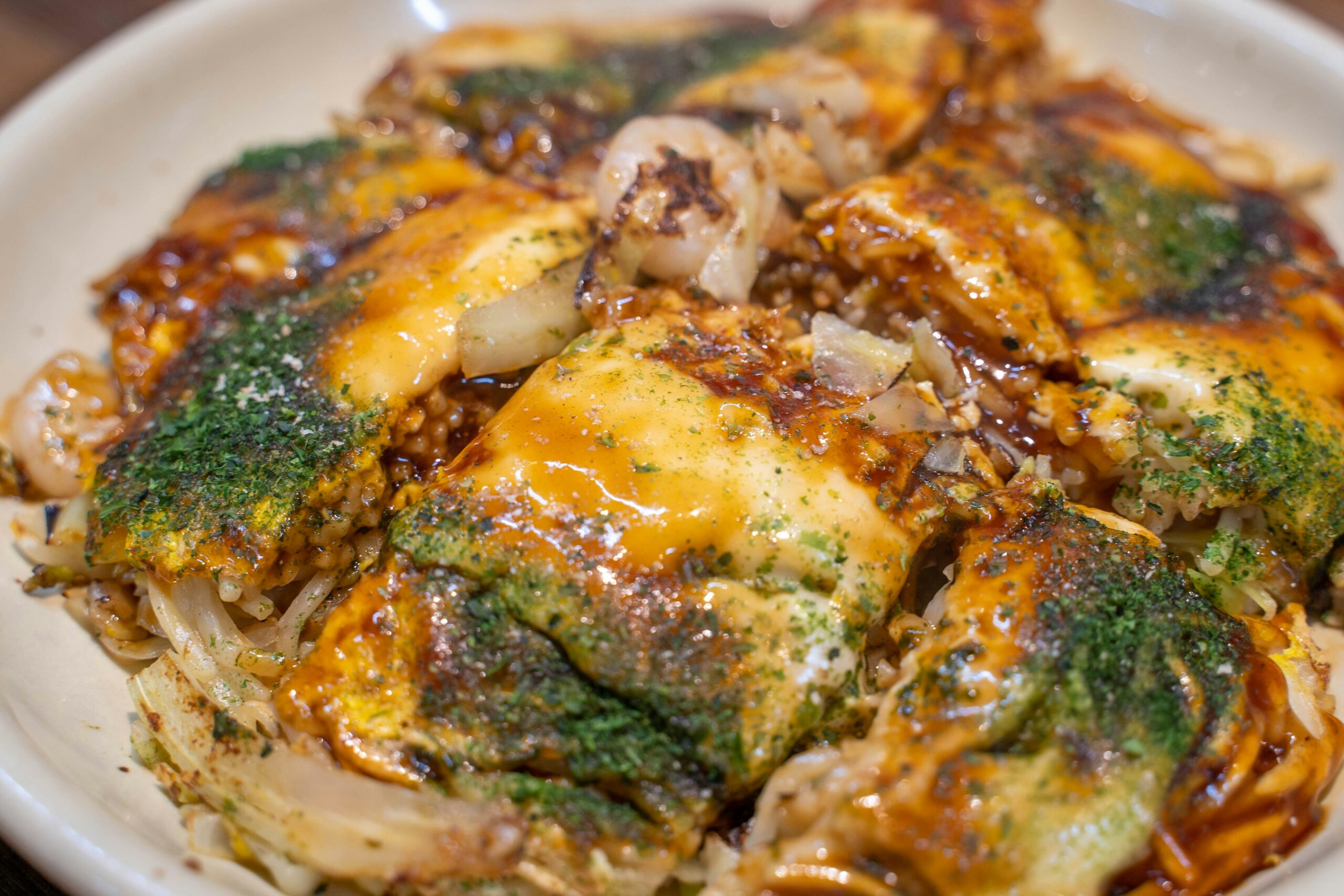 お好み焼き 「お好み焼き」は、小麦粉、山芋、卵、千切りキャベツなどから作られる生地に、肉、魚介類、野菜など様々な具材を入れて作る、日本の粉もの料理です。鉄板で焼き、一般的にはお好み焼きソース、マヨネーズ、鰹節、乾燥海苔、時には漬け生姜などでトッピングされます。 | “Okonomiyaki is a savory Japanese pancake made with a batter consisting of flour, grated yam, eggs, shredded cabbage, and various ingredients such as meat, seafood, or vegetables. It is cooked on a griddle and typically topped with okonomiyaki sauce, mayonnaise, bonito flakes, dried seaweed, and sometimes pickled ginger.” 「grate: おろす」「griddle: 鉄板」 |
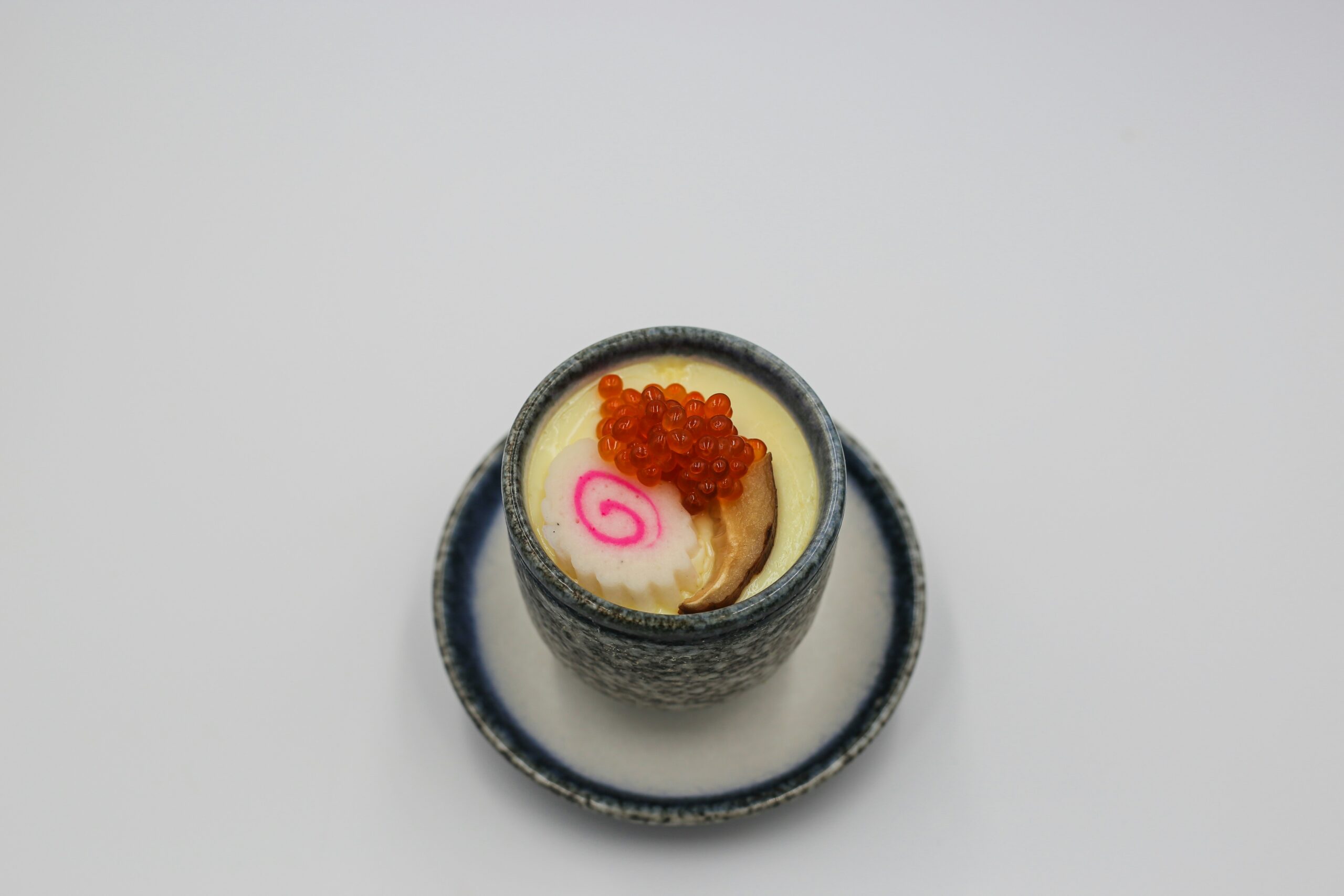 茶碗蒸し 茶碗蒸しは、日本の伝統的な料理であり、主に茶碗に入れて蒸し焼きにした卵液に具材を加えた料理です。一般的には、鶏肉や海老、きのこなどの具材が使われ、ダシや醤油などの調味料で味付けされます。茶碗蒸しは、柔らかく滑らかな口当たりと、深い味わいが特徴で、和食の一品として親しまれています。 | Chawanmushi is a traditional Japanese dish consisting of a steamed egg custard with various ingredients added, typically served in a tea cup or bowl. Commonly, ingredients such as chicken, shrimp, mushrooms, and vegetables are used, seasoned with dashi and soy sauce. Chawanmushi is known for its smooth texture and rich flavor, making it a popular dish in Japanese cuisine. 「season: 味つける」「texture: 口当たり」 |
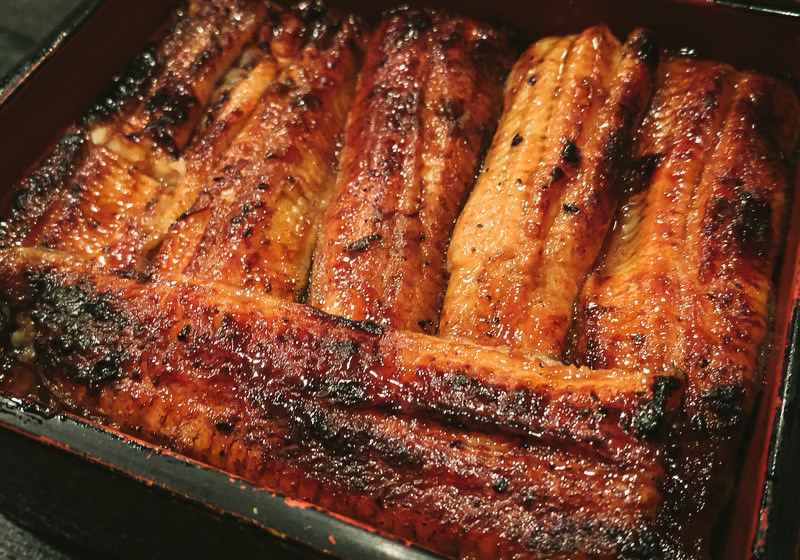 かば焼き かば焼きは、日本の伝統的な焼き魚料理であり、カツオの身を塩で下味をつけて焼いたものです。薄くスライスされ、一般的には醤油やわさびを添えて食べられます。かば焼きは、日本の家庭や居酒屋で一般的に提供され、風味豊かな料理として人気があります。 | Kabayaki is a traditional Japanese grilled fish dish made from salted bonito fillets. The fish is thinly sliced and typically served with soy sauce and wasabi. Kabayaki is commonly found in Japanese households and izakayas, and it is appreciated for its flavorful taste. 「bonito: かつお」 |
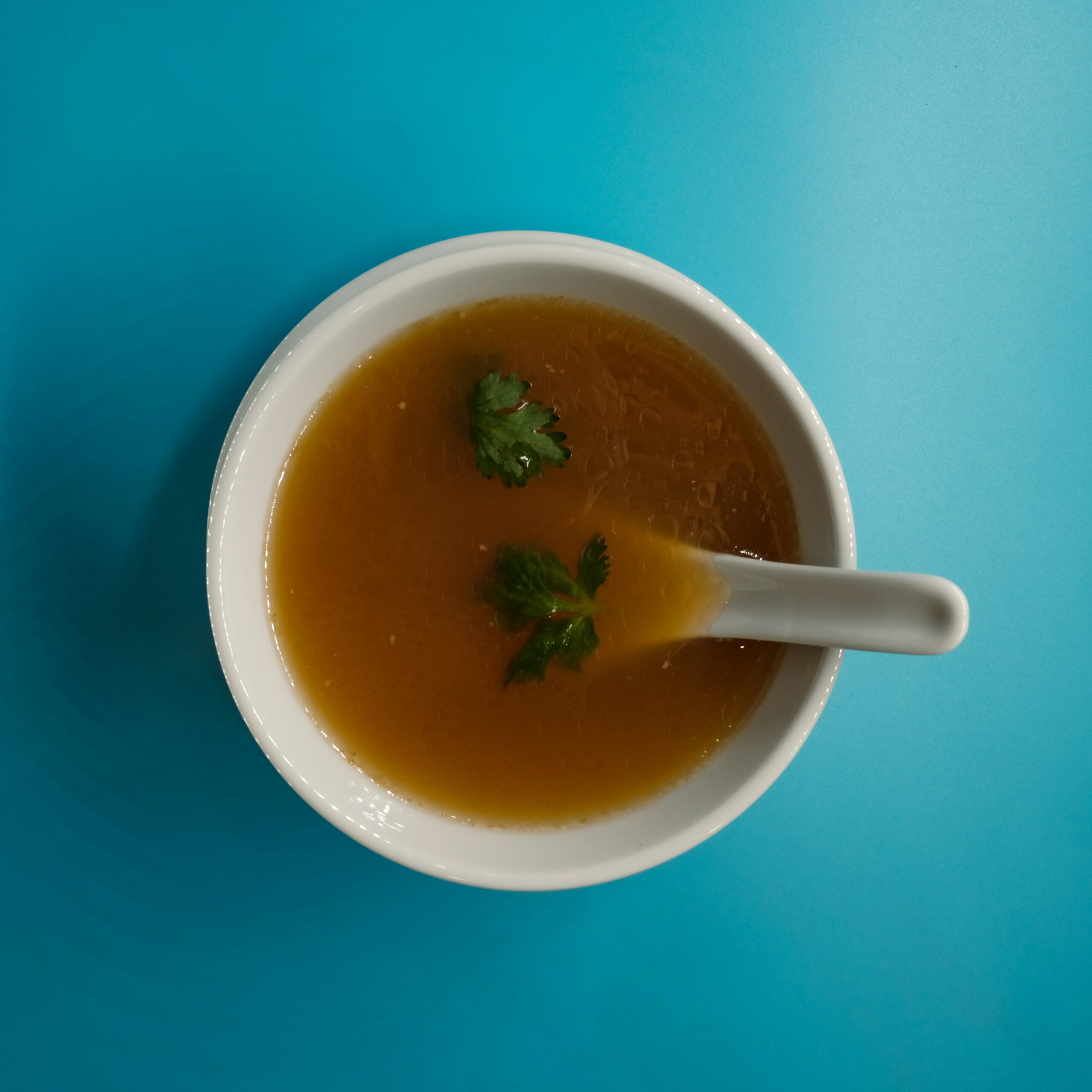 味噌 味噌は、日本の伝統的な調味料であり、大豆や米などを原料として作られる発酵食品です。豆や穀物を煮たり発酵させた後、塩と麹(こうじ)を加えて熟成させることで作られます。味噌は日本の多くの料理に使用され、スープや煮物、調味料などに広く利用されます。 | Miso is a traditional Japanese seasoning made from fermented soybeans and sometimes grains like rice. It is produced by cooking and fermenting the beans or grains, then adding salt and koji (a type of mold) to mature. Miso is used in many Japanese dishes, including soups, stews, and as a seasoning. 「ferment: 発酵させる」「grain; 穀物」 |
 石焼き芋 石焼き芋は、日本の伝統的な焼き芋料理であり、さつまいもを石や炭火で焼いて調理したものです。さつまいもは皮ごと焼かれ、その内部が甘くふっくらとした食感になります。石焼き芋は、日本の秋や冬に特に人気があり、屋台やイベント会場などでよく販売されます。 | Ishiyaki-imo is a traditional Japanese dish of roasted sweet potatoes, cooked over stones or charcoal. The sweet potatoes are roasted whole, including the skin, resulting in a sweet and fluffy texture inside. Ishiyaki-imo is particularly popular in Japan during autumn and winter, and it is often sold at stalls and event venues. 「charcoal: 炭火」「fluffy: ふっくらとした」 |
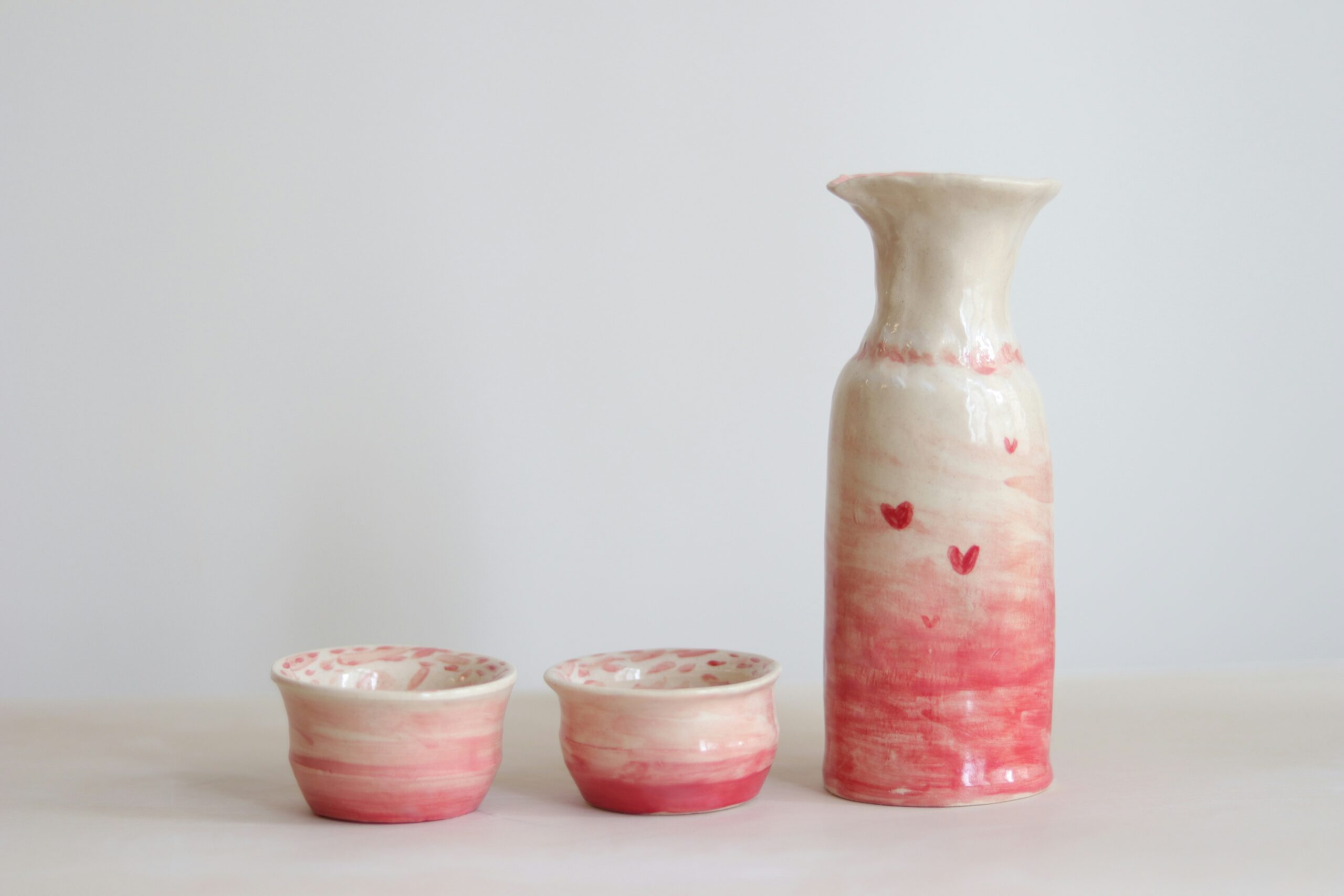 酒 酒は、発酵させた原料から作られるアルコール飲料であり、古くから世界各地で飲まれてきた。日本では、米、大麦、米麹などを原料として作られる日本酒や、米を主原料とする焼酎、麦を使うウイスキーなどが代表的な酒として知られる。酒は、宴会や祝い事などの様々な場面で飲まれ、文化や伝統にも深く根付いている。 | Sake is an alcoholic beverage made from fermented ingredients, and it has been consumed worldwide since ancient times. In Japan, sake made from rice, barley, and rice koji is known as “nihonshu”, while shochu, primarily made from rice, and whisky, made from barley, are also representative types of alcohol. Sake is consumed in various social settings such as gatherings and celebrations, deeply rooted in culture and tradition. 「ferment: 発酵させる」「barley: 大麦」 |
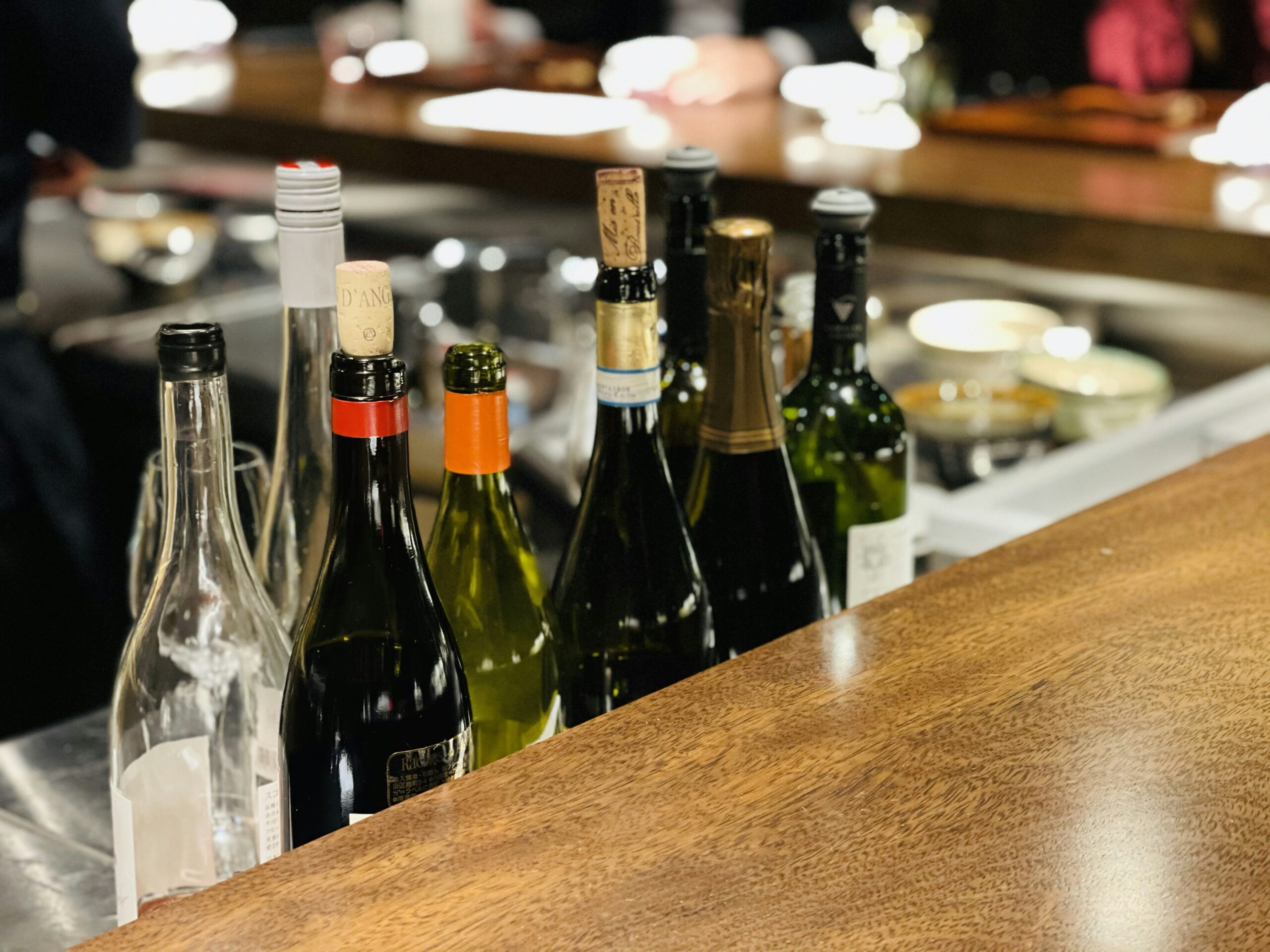 しょうちゅう しょうちゅうは、日本の伝統的な焼酎と呼ばれる蒸留アルコール飲料であり、米、さとうきび、さつまいもなどを原料として作られます。一般的には、米を原料としたしょうちゅうが最もよく知られています。しょうちゅうは、アルコール度数が高く、さまざまな飲み方があります。焼酎は、日本の居酒屋や飲食店でよく提供される一般的なお酒です。 | Shochu is a traditional Japanese distilled alcohol beverage, typically made from ingredients such as rice, sugarcane, or sweet potatoes. Rice-based shochu is the most well-known variety. Shochu has a high alcohol content and can be enjoyed in various ways. It is a popular alcoholic beverage often served in izakayas and restaurants throughout Japan. 「distill: 蒸留する」 |
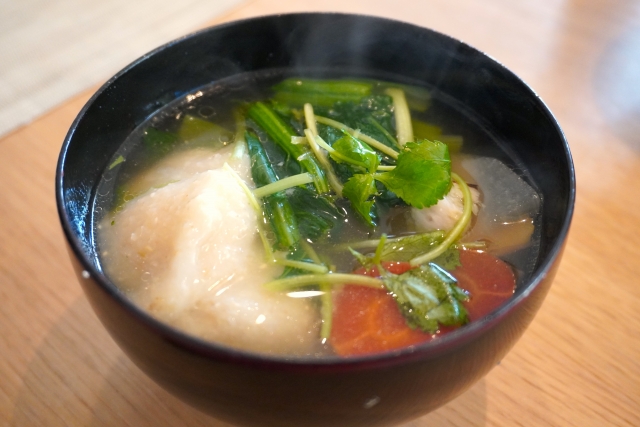 雑煮 Zoni(雑煮)は、通常、正月のお祝いの際に食べられる伝統的な日本のスープ料理です。大豆醤油や味噌で味付けされたクリアなスープに、もちやさまざまな野菜などの具材が入っています。ぞうには、来る年の幸運と繁栄の象徴として文化的な意味があります。日本のさまざまな地域では、材料や調理法が異なる場合があります。 | Zoni is a traditional Japanese soup dish typically eaten during the New Year’s celebration. It consists of a clear broth flavored with soy sauce or miso, containing ingredients such as mochi (glutinous rice cakes) and various vegetables. Zoni holds cultural significance as a symbol of good luck and prosperity for the coming year. It varies in ingredients and preparation methods across different regions of Japan. 「broth: だし汁」 |
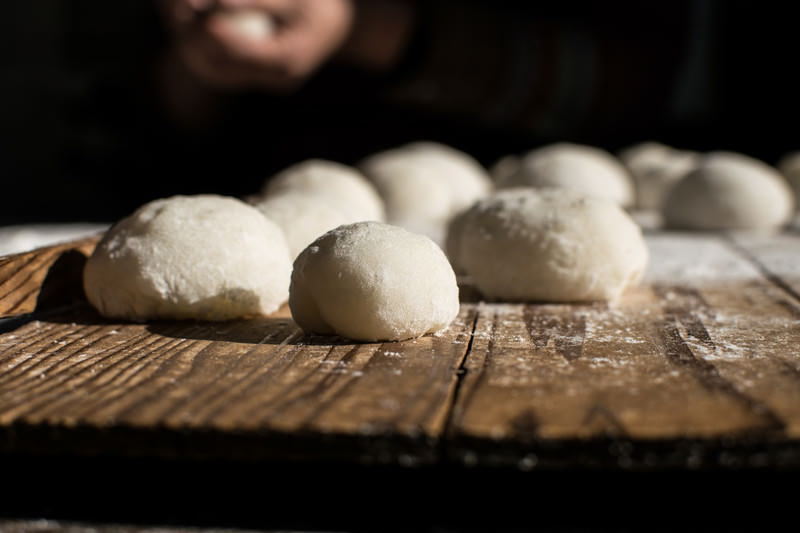 もち 餅(もち)は、もち米を練り上げて作られた伝統的な日本のお餅で、厚くてもちもちしたペーストになります。さまざまな形や大きさに成形され、甘いものからしょっぱいものまでさまざまな料理で楽しむことができます。餅は、日本では特に休日や特別な行事の際に人気の食べ物であり、日本の料理や伝統に文化的な意味を持っています。 | Mochi is a traditional Japanese rice cake made from glutinous rice (also known as sticky rice or sweet rice) that has been pounded into a thick, chewy paste. It is often molded into various shapes and sizes and can be enjoyed in both sweet and savory dishes. Mochi is a popular food in Japan, particularly during holidays and special occasions, and it holds cultural significance in Japanese cuisine and traditions. 「glutinous(グルーティナス): もちもちした、粘着質の」 |
 しるこ しるこ、または「おしるこ」とも呼ばれる、伝統的な日本のデザートスープです。甘い小豆のペースト(あんこ)と水またはだし汁で作られ、砂糖やはちみつで甘くし、塩や柑橘の皮で風味付けされることもあります。通常は温かく供され、特に寒い季節や祝日に楽しまれます。しるこはその温かさと甘さで評価され、日本の料理で人気のあるお菓子です。 | Shiruko, also known as “oshiruko” (お汁粉), is a traditional Japanese dessert soup made from sweet red bean paste (anko) and water or dashi broth, sweetened with sugar or honey, and sometimes flavored with salt or citrus zest. It is often served hot and enjoyed especially during colder months or on festive occasions. Shiruko is appreciated for its comforting warmth and sweet flavor, making it a popular treat in Japanese cuisine. 「sweet red bean paste: あんこ」「broth: 出汁」「zest: 皮」 |
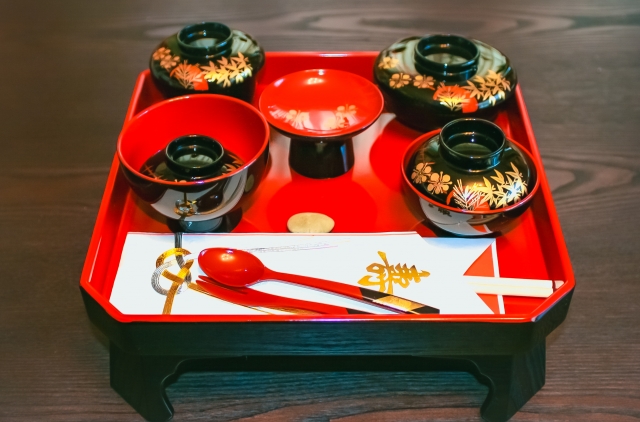 精進料理 精進料理(しょうじんりょうり)は、禅仏教に根ざした伝統的な日本の菜食料理です。植物性の食材とシンプルな調理法に焦点を当て、栄養価の高く風味豊かな料理を作り出します。この料理では、季節の野菜、穀物、豆類、そして豆腐が重視され、蒸し、煮る、煮込むなどの調理法が用いられます。精進料理は、瞑想の一環として寺院で楽しまれ、食事を通じてマインドフルネスと感謝の気持ちを育むことを目指します。 | Shojin-ryori is a traditional Japanese vegetarian cuisine rooted in Zen Buddhism. It focuses on plant-based ingredients and simple cooking methods to create nutritious and flavorful dishes. This cuisine emphasizes seasonal vegetables, grains, legumes, and tofu, prepared with techniques like steaming and boiling. Shojin-ryori is enjoyed in temples for meditation and promotes mindfulness and gratitude through food. |
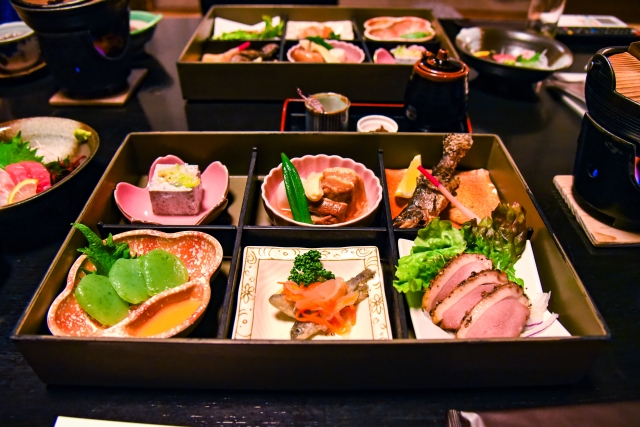 懐石料理 懐石料理(かいせきりょうり)は、季節の食材、細心の準備、そして優雅なプレゼンテーションで知られる伝統的な日本の多段式の食事です。小さな、美しく盛り付けられた料理が、さまざまな味と食感を楽しめます。この料理は茶道の実践から生まれ、特別な食事体験として、高級レストランや伝統的な旅館で楽しまれています。 | Kaiseki-ryori is a traditional Japanese multi-course meal known for its seasonal ingredients, meticulous preparation, and elegant presentation. It consists of small, beautifully arranged dishes showcasing a variety of flavors and textures. This culinary art form originated from the tea ceremony practice and is enjoyed at upscale restaurants and traditional inns as a special dining experience. 「meticulous: 細部まで手の込んだ」「upscale: 高級な」 |
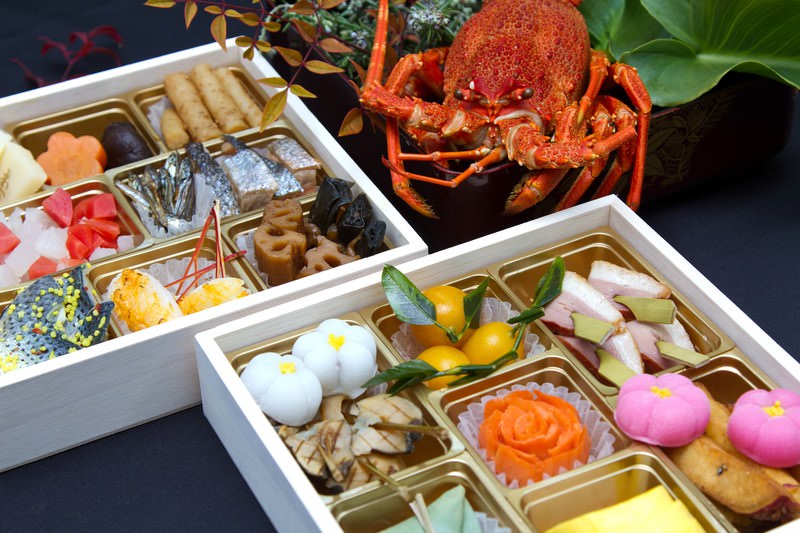 おせち料理 おせち料理(おせちりょうり)は、特別な弁当箱に詰められた様々な伝統的な日本の正月料理です。来る年の繁栄と幸福を象徴する厳選された料理が含まれています。 | Osechi-ryori is a traditional Japanese New Year’s cuisine served in special bento boxes. It consists of a variety of meticulously prepared dishes symbolizing prosperity and happiness for the coming year. 「meticulously: 慎重に」 |
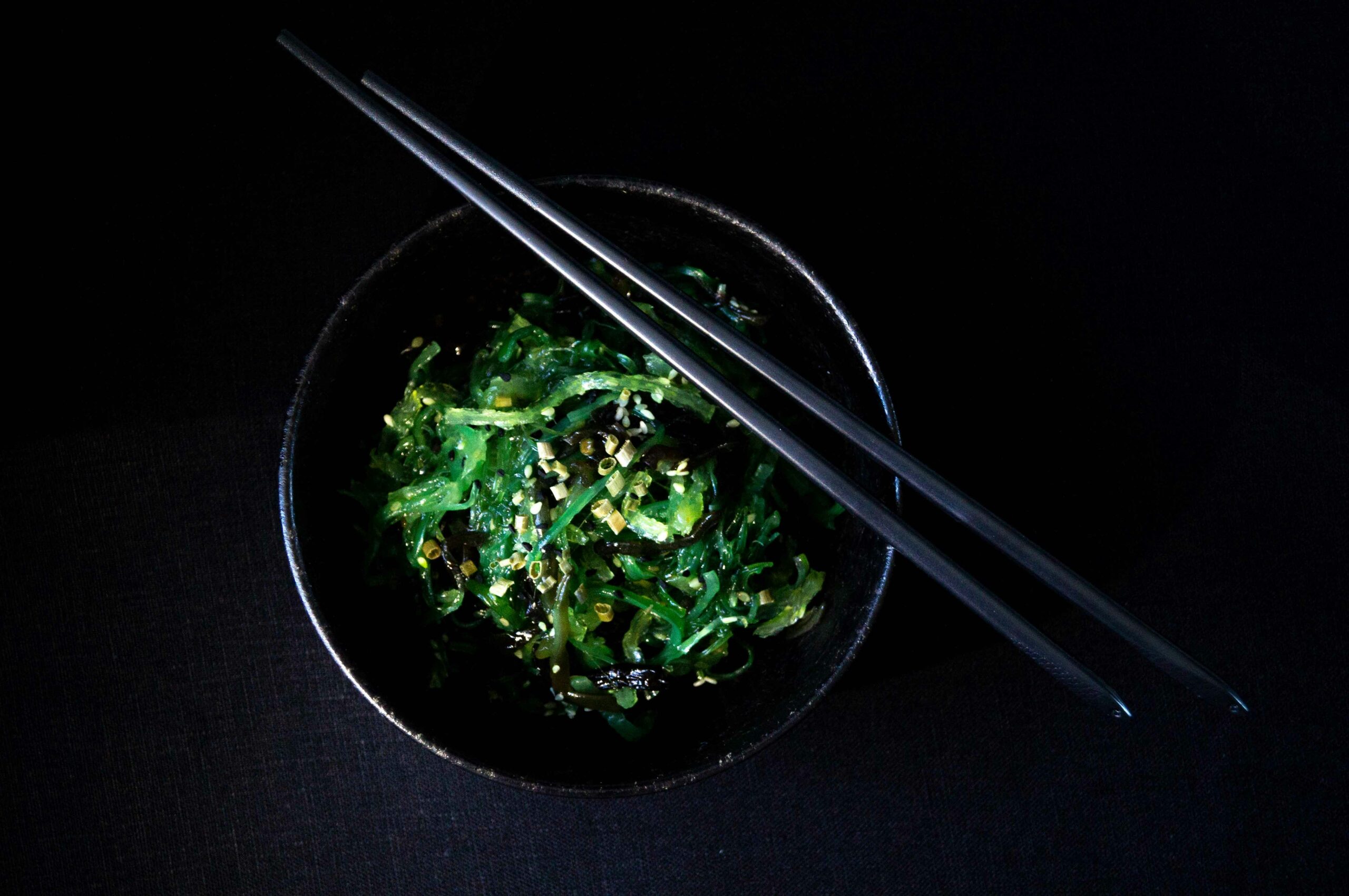 酢の物 酢の物(すのもの)は、日本の伝統的な料理で、酢をベースにしたさっぱりとしたサラダです。一般的には、キュウリや海藻、大根などの野菜を薄く切って酢と砂糖、塩で味付けし、時には魚介類や海産物を加えて作られます。夏場に特に人気があり、さっぱりとした味わいが暑い季節にぴったりです。 | Sunomono is a traditional Japanese dish, a refreshing salad based on vinegar. Typically, thinly sliced vegetables such as cucumber, seaweed, and daikon are seasoned with vinegar, sugar, and salt. Sometimes seafood or shellfish are added. It’s particularly popular during the summer months, offering a light and refreshing taste that’s perfect for hot weather. |
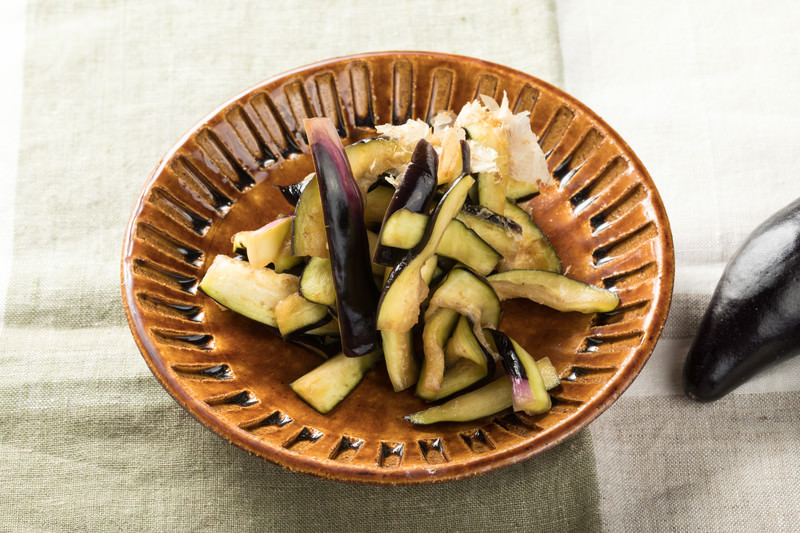 漬物 漬物(つけもの)は、野菜を塩、米糠、酢、または醤油で漬け込んだ日本の伝統的な副菜です。パリパリから柔らかくてやや甘いものまでさまざまな味わいがあり、ご飯と一緒に食べられ、濃厚な料理との爽やかな対比を楽しめます。 | Tsukemono, or Japanese pickles, are a traditional side dish made by pickling various vegetables in salt, rice bran, vinegar, or soy sauce. They offer a wide range of flavors and textures, from crunchy to soft and mildly sweet, and are often served alongside rice dishes to provide a refreshing contrast. 「rice bran: 米ぬか」 |
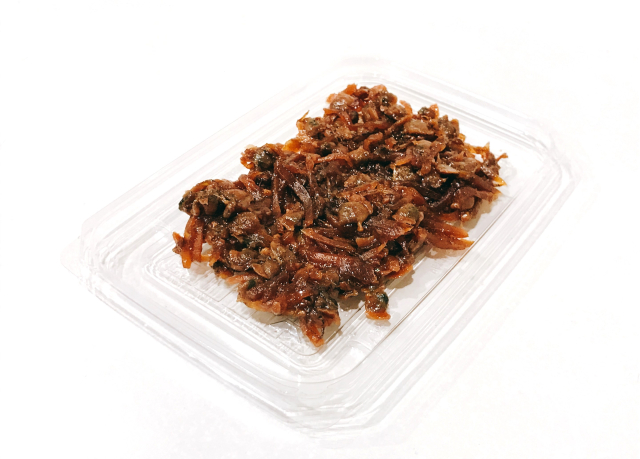 佃煮 つくだには、主に魚や海藻などを醤油や砂糖などで煮詰めた、濃厚な調味料です。一般的には小さな保存容器に入れて、ご飯のおかずとして食べることが多いです。つくだには、日本の家庭料理やお土産品として人気があります。 | Tsukudani is a thick condiment made by simmering ingredients such as fish or seaweed in soy sauce, sugar, and other seasonings. It is typically packed in small jars or containers and enjoyed as a side dish with rice. Tsukudani is popular as a staple in Japanese home cooking and as a souvenir item. 「condiment: 調味料」「simmering: 煮詰める」「staple: 定番となる食料」 |
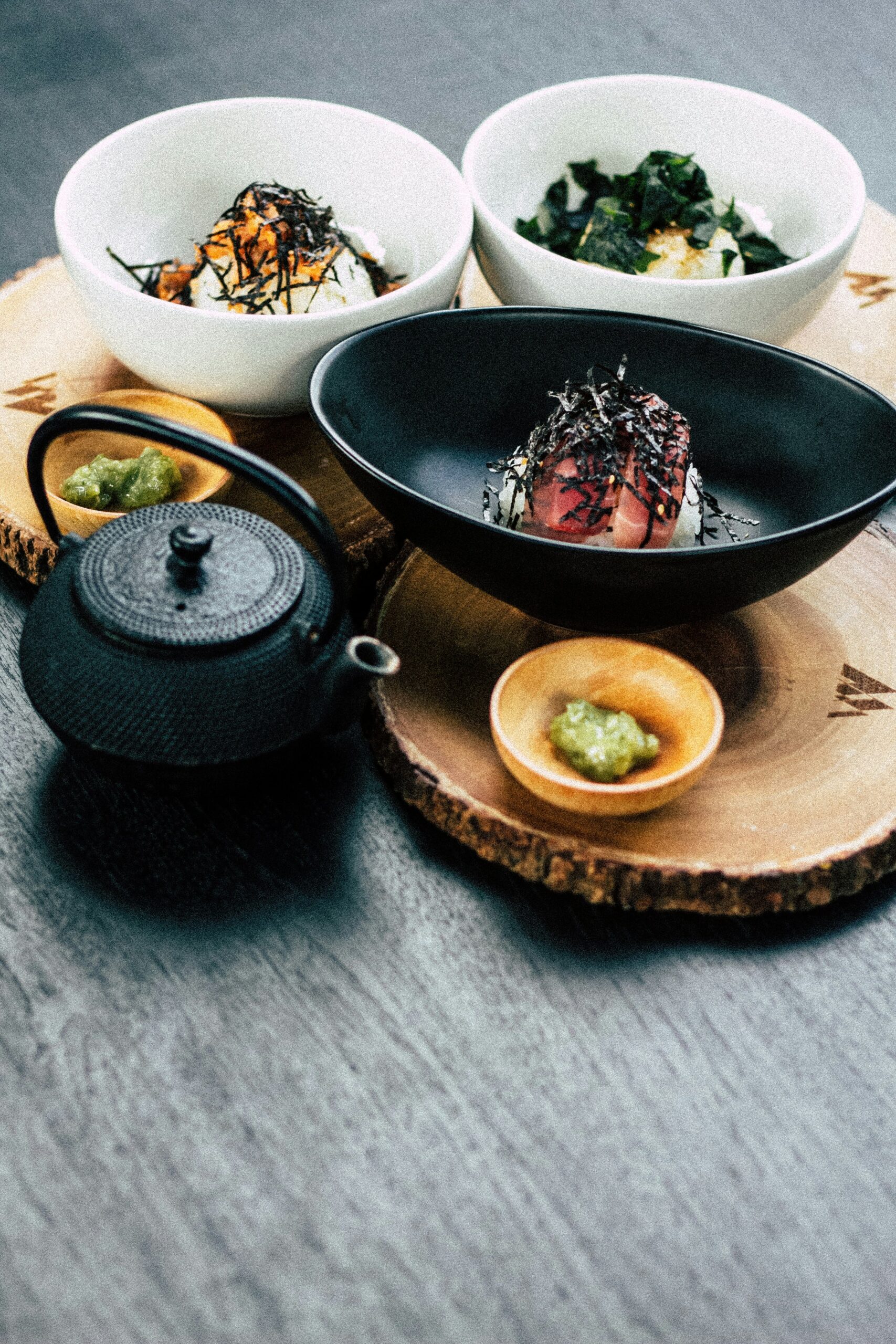 お茶漬け お茶漬けは、温かいご飯にお茶やだしをかけて食べる日本の料理です。具材としては、梅干し、焼きのり、鮭、漬物などが使われることが一般的です。お茶漬けは、軽食や食後の一品として親しまれています。 | Ochazuke is a Japanese dish made by pouring hot tea or dashi broth over cooked rice. Common toppings include umeboshi (pickled plum), nori seaweed, salmon, and pickles. Ochazuke is often enjoyed as a light meal or as a dish served after the main course. |
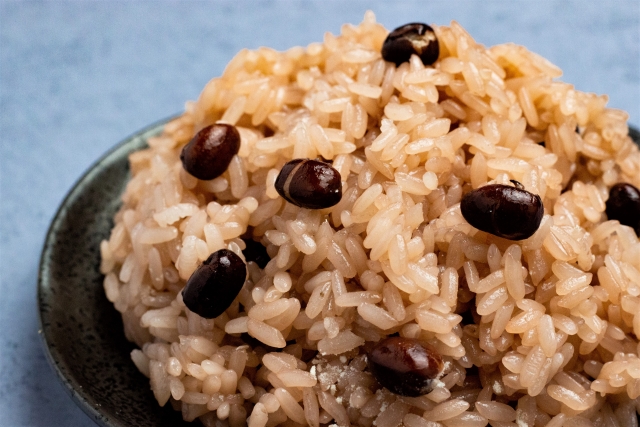 赤飯 赤飯(せきはん)は、日本の伝統的なお祝い料理の一つであり、主にお正月や祝い事の際に食べられます。白米にもち米を混ぜて炊き、それにあずきや紅花を加えて煮たものです。その赤い色合いから「赤飯」と呼ばれています。赤飯は、幸福や祝福を願う意味合いも持ちます。 | Sekihan, also known as “red rice,” is a traditional Japanese celebratory dish often eaten during New Year’s and other special occasions. It is made by cooking glutinous rice (mochigome) together with regular white rice, and then adding azuki beans and sometimes safflower to give it a red color. The vibrant red hue is where it gets its name from. Sekihan is symbolic of happiness and blessings, making it a cherished dish for festive gatherings. 「glutinous: 粘着性の」「safflower: 紅花」 |
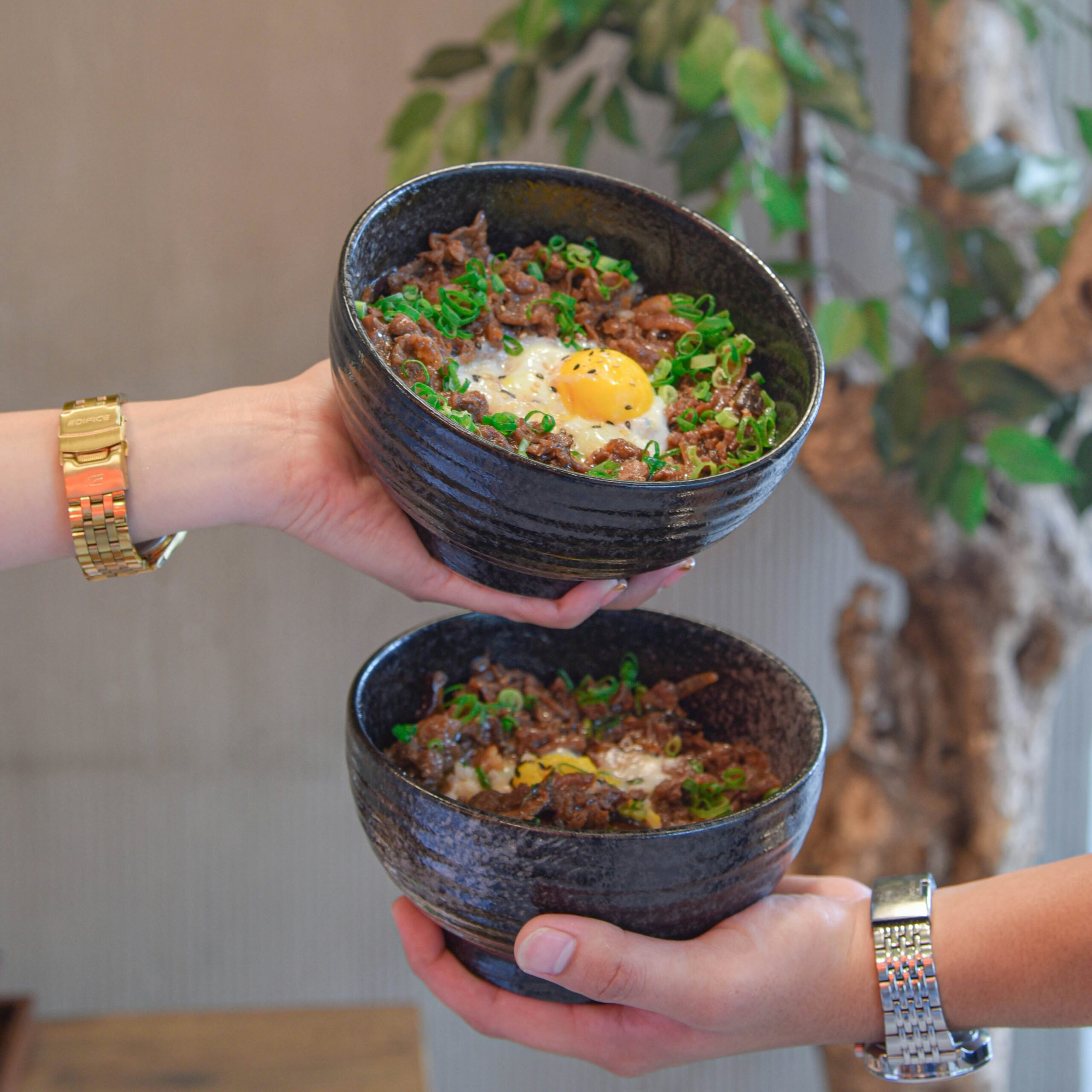 どんぶり物 丼物(どんぶりもの)は、丼に盛られたご飯の上に、具材やおかずをのせた日本の料理の総称です。代表的な丼物には、親子丼、かつ丼、天丼などがあります。具材としては、肉や魚、野菜、卵などが使われ、味付けはシンプルなものから濃厚なものまでさまざまです。丼物は手軽でボリュームがあり、日常的に食べられる定番の料理として親しまれています。 | Donburimono, or simply “donburi,” refers to a variety of Japanese dishes served in a bowl (donburi) over a bed of rice, typically with various toppings or side dishes. Representative examples of donburi include oyakodon (chicken and egg bowl), katsudon (deep-fried pork cutlet bowl),and tendon (tempura bowl). Ingredients commonly used in donburi include meat, fish, vegetables, and eggs, and the seasoning can range from simple to rich and flavorful. Donburi dishes are popular for their convenience, generous portions, and are enjoyed as staple meals in everyday dining. 「staple: 定番となる食事」 |
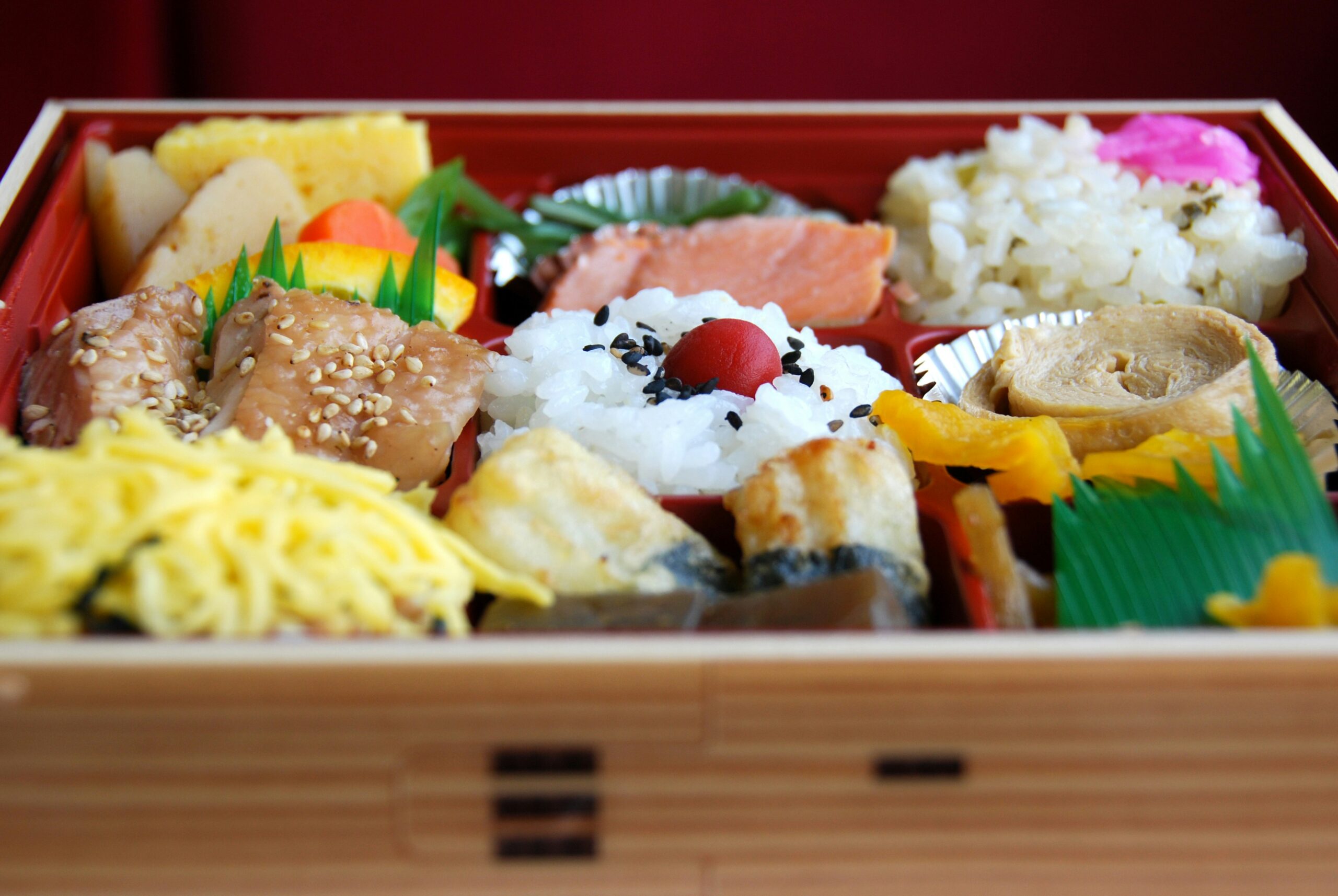 幕の内弁当 幕の内弁当(まくのうちべんとう)は、日本の伝統的なお弁当で、ご飯やおかず、漬物、たまご焼きなどが入っています。 | Makunouchi bento is a traditional Japanese lunch box containing rice, various side dishes, pickles, and tamagoyaki (Japanese rolled omelette). |
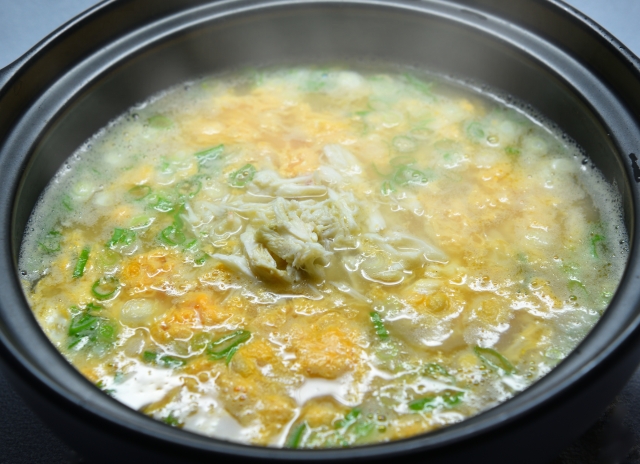 ぞうすい 雑炊(ぞうすい)は、日本の伝統的な料理で、残り物のご飯や具材を出汁で煮込んだスープです。主に食事の残りや飲み会の後などに食べられ、体を温めるためにもよく食べられます。お好みで、梅干しや海苔、玉ねぎなどの具材を加えて味を調えることもあります。 | Zosui is a traditional Japanese dish made by simmering leftover rice and ingredients in dashi broth to create a comforting soup. It is typically eaten after a meal or at drinking parties and is often enjoyed for its warming properties. Additional ingredients such as umeboshi (pickled plum), nori seaweed, or onions may be added to adjust the flavor according to personal preference. 「simmering: 煮詰めた」 |
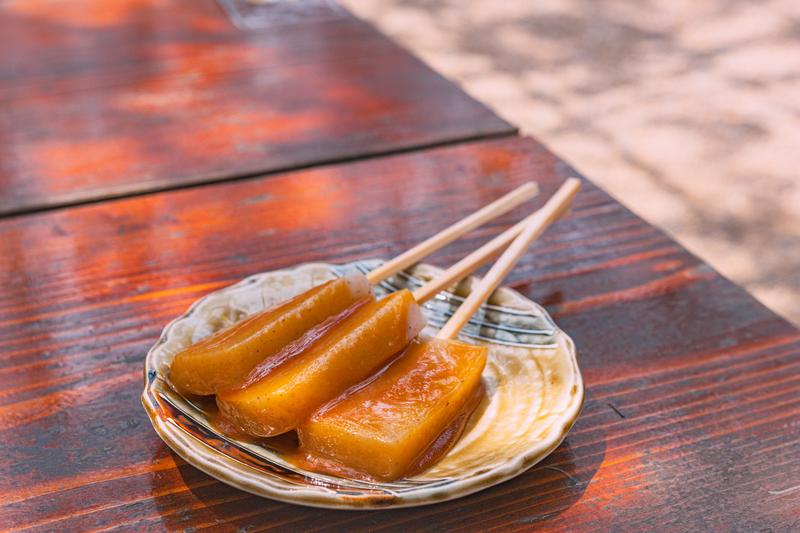 こんにゃく こんにゃくは、日本の食品であり、こんにゃく芋から作られる食物繊維の豊富な食材です。こんにゃくは、低カロリーであり、食物繊維が豊富であり、食事の間の間食としても良く食べられます。一般的には、こんにゃくはスープや煮物、麺類の代替として使用されます。 | Konnyaku is a Japanese food product made from the konjac yam and is rich in dietary fiber. It is low in calories and high in fiber, making it a popular snack between meals. Typically, konnyaku is used as a substitute in soups, simmered dishes, and noodles. |
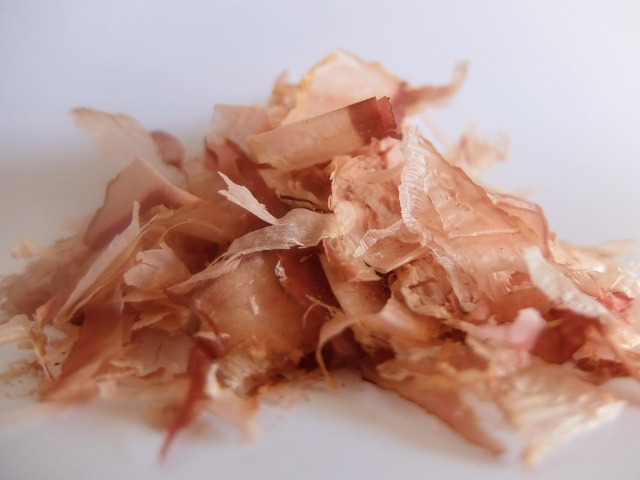 かつおぶし 鰹節(かつおぶし)は、日本の食品であり、カツオの背中の部分を乾燥させ、薄く削ったものです。鰹節は、和食の料理において風味豊かな調味料として広く使用されており、特に出汁の素材として重宝されます。その風味と香りは、料理に深い味わいを加えます。 | Katsuobushi is a Japanese food product made from dried, thinly shaved bonito (skipjack tuna) flakes. It is widely used as a flavorful seasoning in Japanese cuisine, particularly valued as a key ingredient in dashi broth. Its rich umami flavor and aroma enhance the taste of dishes, adding depth and complexity to the flavor profile. |
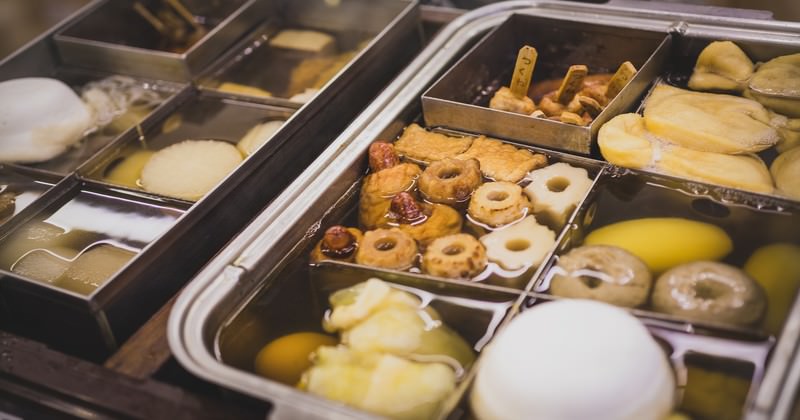 ちくわ Chikuwa (竹輪)は、加工された魚のペーストから作られ、円筒形に成形され、焼かれたり茹でられたりする日本の食品です。しっかりとした食感と穏やかな味が特徴で、おでんなどの料理や麺のトッピングとしてよく使われます。 | Chikuwa (竹輪) is a Japanese food made from processed fish paste, shaped into cylindrical tubes, and grilled or boiled. It has a firm texture and mild flavor, commonly used in dishes like oden or as a noodle topping. 「texture: 食感」 |
 かまぼこ 蒲鉾(かまぼこ)は、魚のペーストを成形し、蒸したり焼いたりして作られる日本の食品です。なめらかな食感とやさしい、わずかに甘い味が特徴です。蒲鉾はよく薄切りにしてスナックとして食べたり、スープや麺のトッピングとして使われます。 | Kamaboko (蒲鉾) is a Japanese food made from pureed fish paste, shaped into various forms, and steamed or grilled. It has a smooth texture and a mild, slightly sweet flavor. Kamaboko is often sliced and served as a snack or used as a topping for soups and noodles. 「pureed: ピューレ仕立ての」「texture: 食感」 |
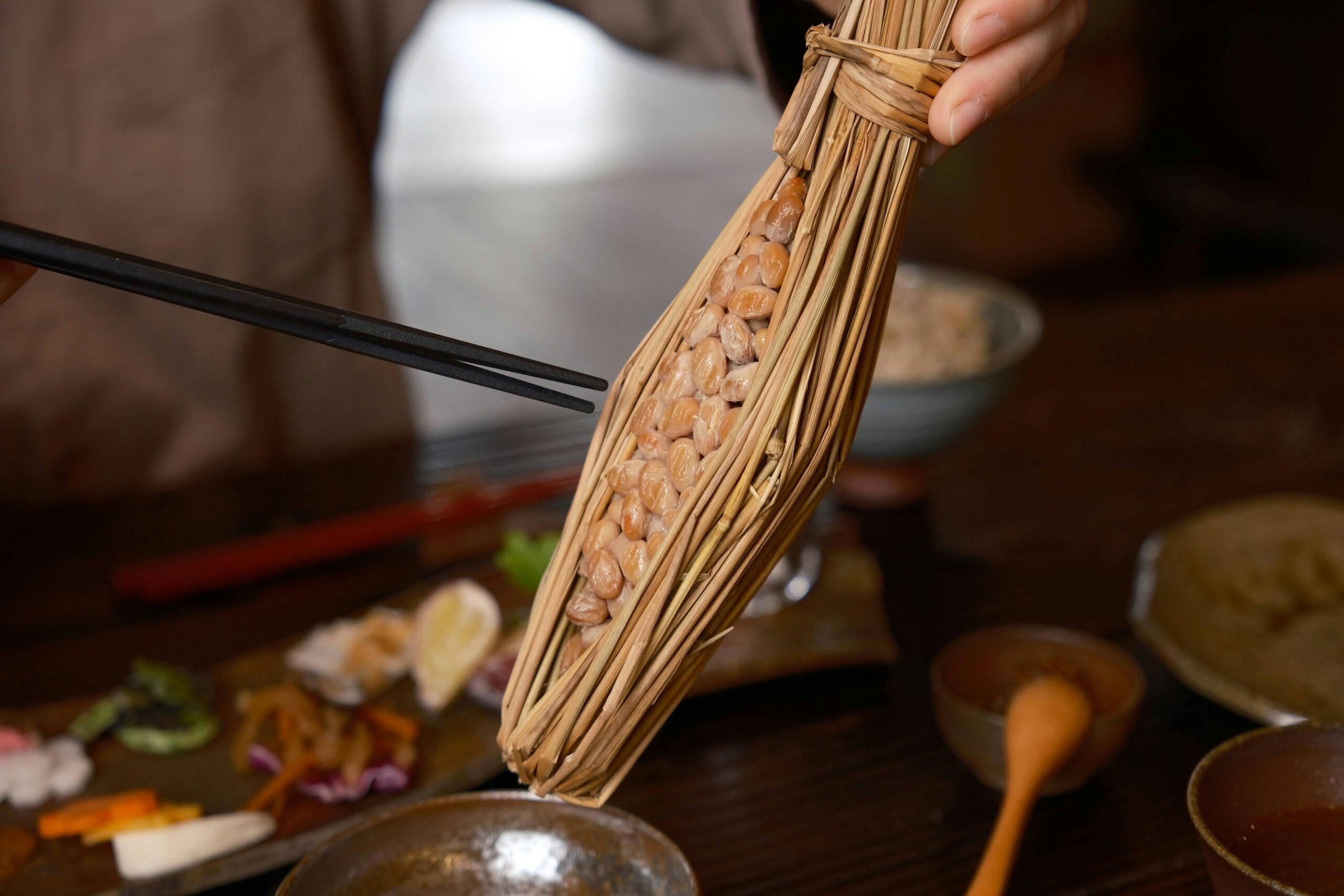 なっとう 納豆(なっとう)は、大豆を発酵させて作られる伝統的な日本食です。粘り気のある食感と強い香りが特徴です。納豆はよくご飯と一緒に食べられ、朝食として提供されます。健康に良いとされ、たんぱく質やビタミンK2などの栄養素が豊富です。 | Natto (納豆) is a traditional Japanese food made from fermented soybeans. It has a sticky texture and strong, pungent flavor. Natto is often eaten with rice and served as a breakfast dish. It is known for its health benefits and is rich in nutrients such as protein and vitamin K2. 「fermented: 発酵させた」「texture: 食感」「pungent: 刺激が強い」 |
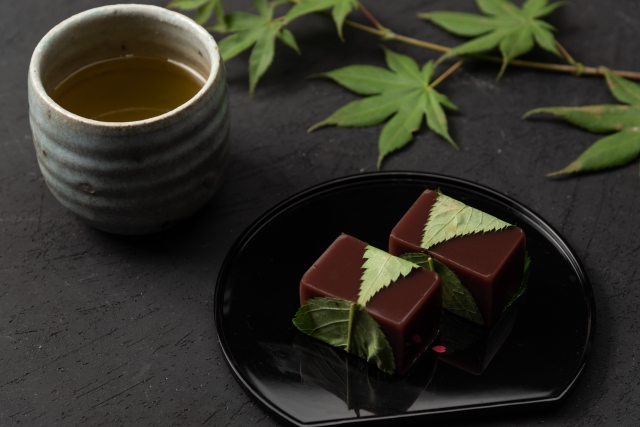 ようかん Yokan (羊羹)は、あんこ、寒天、砂糖から作られる伝統的な日本のデザートです。しっかりとしたゼリー状の食感で、特別な場面や茶の湯で楽しまれます。 | Yokan (羊羹) is a traditional Japanese dessert made from red bean paste, agar agar, and sugar. It has a dense, jelly-like texture and is enjoyed as a snack or dessert during special occasions and tea ceremonies in Japan. 「agar agar: 寒天」「texture: 食感」 |
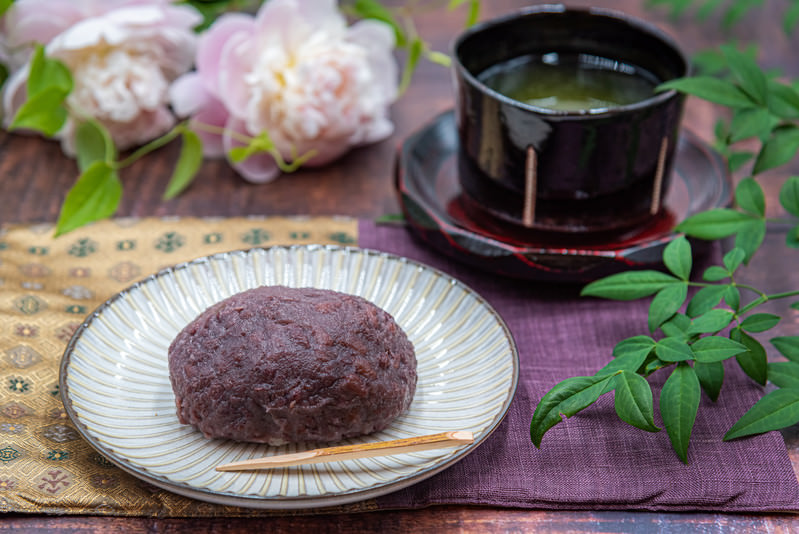 おはぎ おはぎは、もち米と甘いあんこから作られる伝統的な日本のお菓子です。柔らかくてねっとりした食感で、甘い味が特徴です。彼岸などの秋の祭りでよく楽しまれ、季節の移り変わりを象徴し、日本で人気のあるおやつです。 | Ohagi (おはぎ) is a traditional Japanese sweet made from sticky rice and sweet red bean paste. It has a soft and chewy texture with a sweet flavor, often enjoyed during autumn festivals like Higan. It symbolizes the changing of seasons and is a popular treat in Japan. 「texture: 食感」 |
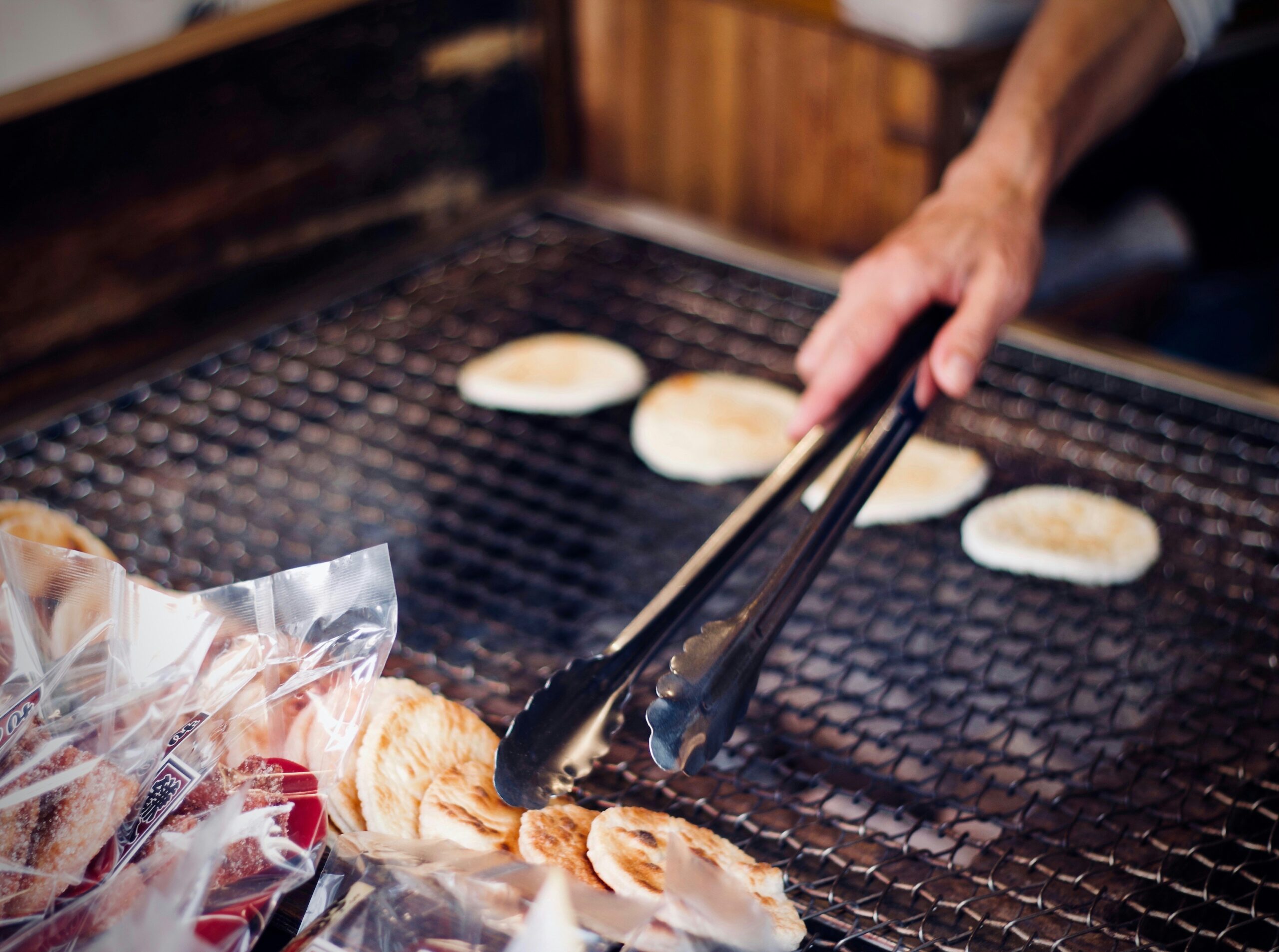 せんべい せんべいは、米、塩、時には醤油や海苔などの風味付けから作られる日本の伝統的な米菓です。焼かれたり焼かれたりして、パリパリとした食感に仕上げられます。さまざまな形やサイズがあり、しょっぱいものから甘いものまであります。日本中で人気のあるスナックで、お茶と一緒に楽しまれることもよくあります。 | Senbei (せんべい) is a traditional Japanese rice cracker made from rice, salt, and sometimes flavorings like soy sauce or seaweed. It comes in various shapes and sizes, and can be savory or sweet. Popular throughout Japan, senbei is enjoyed as a snack and often served with tea. |
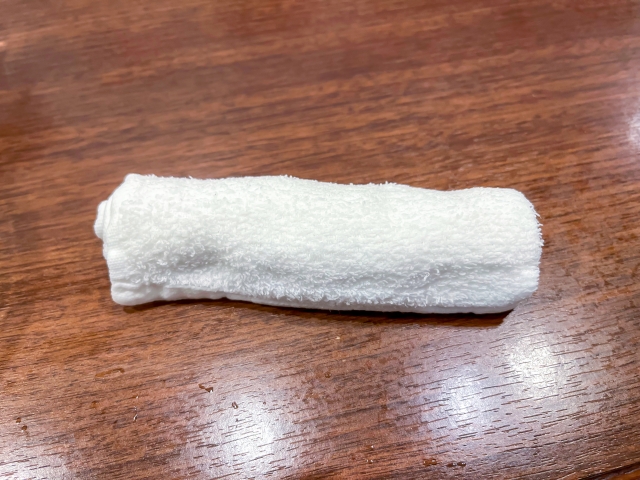 おしぼり おしぼりは、食事の前やリフレッシュする前にゲストに湿ったタオルを提供する日本の習慣です。これは、日本のレストランやホスピタリティ施設でよく見られる、おもてなしと清潔さのジェスチャーです。 | Oshibori is a Japanese custom of offering guests a moistened towel before a meal or to refresh themselves. It’s a gesture of hospitality and cleanliness commonly seen in restaurants and hospitality establishments in Japan. |
 屋台 屋台(やたい)は、日本で見られる移動式の食品売り場で、焼き鳥やたこ焼きなどさまざまな屋台料理が提供されます。彼らは祭りでよく見られ、友人とのカジュアルな食事を楽しむための賑やかな雰囲気を提供します。 | Yatai are mobile food stalls found in Japan, serving a variety of street foods like yakitori and takoyaki. They’re popular at festivals and offer a lively atmosphere for enjoying casual meals with friends. |
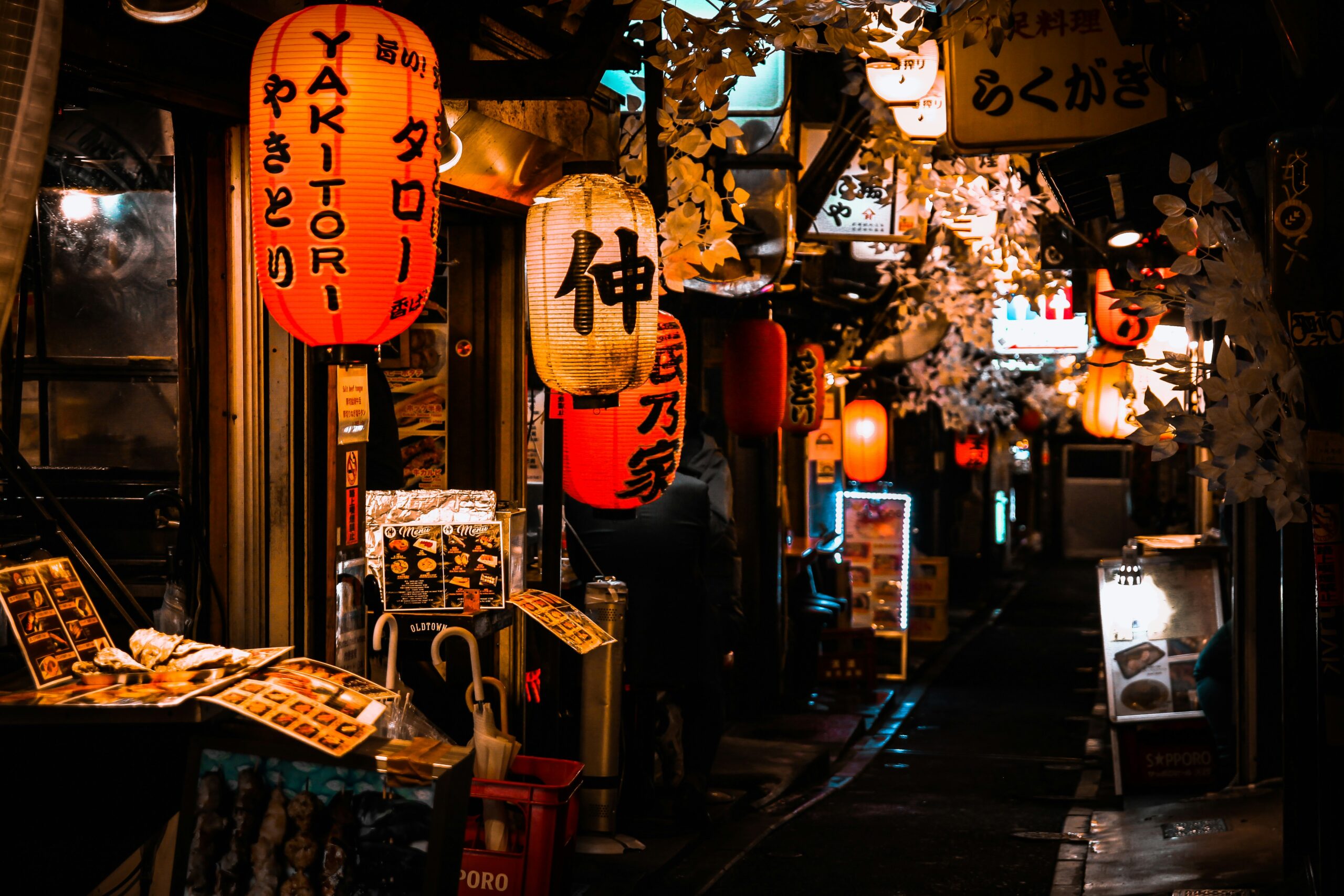 居酒屋 居酒屋(いざかや)は、カジュアルな雰囲気でさまざまな小皿料理とお酒を楽しむことができる日本のパブです。仕事の後や週末に友人や同僚との交流の場として人気があります。 | An izakaya (居酒屋) is a type of Japanese pub where people can enjoy a variety of small dishes and drinks in a casual atmosphere. It’s a popular spot for socializing with friends or colleagues after work or during weekends. |
